Matador Network's Blog, page 212
February 6, 2024
Romer Waikiki Is a Hotel, a Hangout, and a Guidebook in One
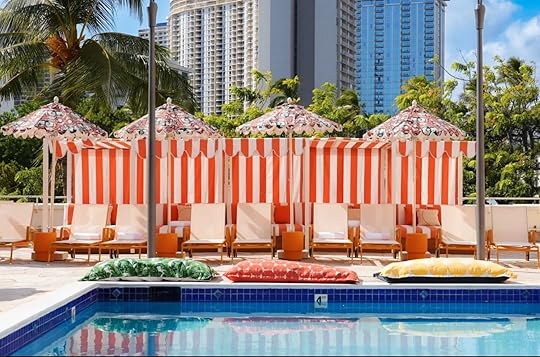
We hope you love Romer Waikīkī! Just so you know, Matador may collect a small commission from the links on this page if you decide to book a stay. Listed prices are accurate as of the time of publication.
The morning after I checked into the Romer Waikīkī at The Ambassador I had breakfast with the mayor. I met Ramona Sidlo, the hotel’s Mayor of the Block, at the Ambassador Neighborhood Cafe, an open-air courtyard attached to the lobby where guests can have breakfast or dinner. We ordered croissant sandwiches with Portuguese sausage, one of many culinary imports that’s become an indelible part of Hawai’i’s multicultural cuisine. She asked about my plans for the day, and I mentioned an interest in venturing to O’ahu’s North Shore.

Photo: Alex Bresler
Sidlo pulled out her phone and texted her friend, Justin, who works for a service called GoVibe that operates as a door-to-door luxury car rental agency. Fifteen minutes later, he pulled up to the hotel’s front entrance in a shiny silver BMW. My partner, Peter, filled out a quick app-based rental agreement, Justin handed us the keys, and like that, we were on our way.
Mayor Ramona has a lot of “friends.” That’s the term Sidlo, whose title at a more conventional hotel might read Experiential Marketing Manager, uses to describe the “mom-and-pop” businesses that Romer Waikīkī partners with to provide guests with experiences while benefiting the community.
GoVibe is one example. Guests can arrange rentals from the O’ahu-based car service through a QR code that’s printed on the back of every room key. The QR code also functions as a guidebook, offering suggestions for what to do and eat in the area. The Waikīkī Brewing Company is another friend of the hotel. With a storefront down the street from Romer Waikīkī, the brewing company provides the complimentary beer that’s doled out in the lobby every day around 4 PM, strategically coinciding with check-in.

Photo: Alex Bresler
More examples can be found in the hotel’s gift shop, which, at a glance, looks more like an art piece. Only upon close inspection does the display case in the lobby announce that the products behind the glass are available for purchase. Items range from bathing suits, to postcards, to body oils, to gilded metal bottle openers in the shape of the shaka, or Hawai’i’s hang loose symbol. According to Sidlo, the hotel has plans to build out its gift shop, if only as a way to spotlight even more local friends.
Some of the hotel’s partnerships are quieter, such as the park across the street that Romer Waikīkī adopted to give back to the neighborhood. Neighborhood values run deep at the hotel. It’s right there in the official name: Romer Waikīkī at The Ambassador. The Ambassador was an iconic if rundown O’ahu hotel that once occupied the space where Romer Waikīkī now stands, the sort of place where generations of locals might remember having their prom, Sidlo explains.
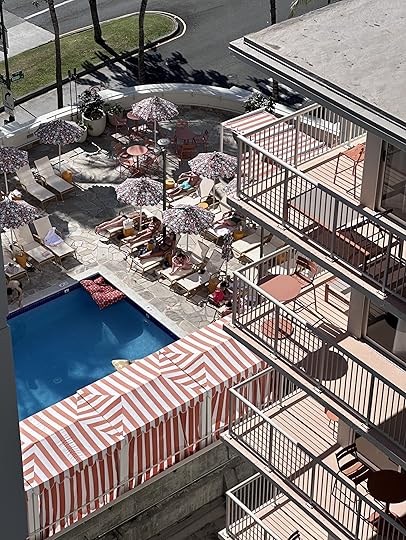
Photo: Alex Bresler
Today’s locals are as welcome at the hotel as guests. In addition to offering discounted rates for government employees and Kamaʻāinas, or Hawai’i residents, neighborhood folks can stop by the cafe, attend goings-on at the hotel, and treat its Waikīkī Swim and Social Club as a public pool. Cabanas and loungers are available for guests and non-guests alike to reserve.
It’s unclear after my two-night stay how many of the people I saw at the pool had rooms at the hotel. In the mornings, the pool area was relatively empty. It livened up in the afternoons, but even for a small space, it never felt crowded.
What crowd I did see was a pleasant mix of people that seems to be representative of the hotel’s everyone-welcome attitude: I saw twenty-something friends sipping frozen Aperol spritzes, a likely thirty-something couple enjoying private time in a cabana, a mom and her young daughter splayed out on loungers, and a mixed-age group of teens and pre-teens who appaeared to be siblings passing a football back and forth across the pool.
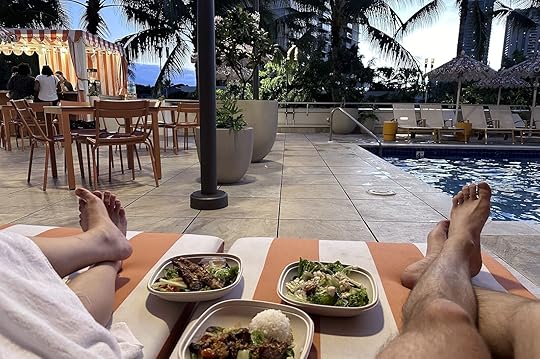
Photo: Alex Bresler
On our last evening at the hotel, while Peter and I sipped spicy margarita-inspired cocktails and ate lemongrass chicken and Thai basil tofu bowls that we’d ordered from the pool menu, what appeared to be a large local family stopped by for a sundown swim.
The inverse is also true. As much as Romer Waikīkī wants to bring the neighborhood to the hotel, it also connects guests with the world outside of the property. Our first night, on Mayor Ramona’s recommendation, Peter and I Ubered to Honolulu for dinner at the Lei Stand, a cocktail bar and restaurant in O’ahu’s Chinatown, which I might not have known existed otherwise. One of its menu items was called Ramona’s cheezy bread — a nod to the mayor’s favorite dish and the sort of reciprocal relationships the hotel is trying to build in the community.
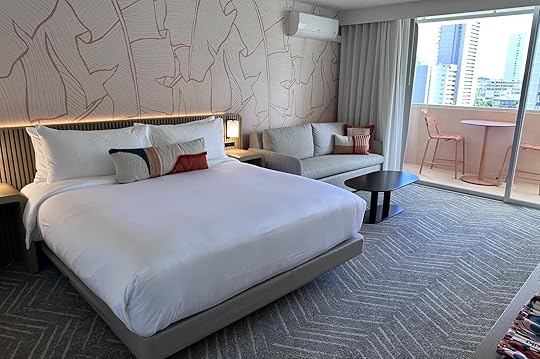
Photo: Alex Bresler
Of course, Romer Waikīkī is, at its core, a hotel. It has the look of a hip renovated motel, a trend that’s been climbing in the hospitality world. The property is located between two relatively busy streets a short walk from one of O’ahu’s main shopping districts. While not directly on the water, a detail that I came to appreciate after spending two nights on busy Waikīkī Beach, it’s close enough to walk, and some of the rooms glimpse the ocean.
The rooms themselves are modern, comfortable, and clean, with floor-to-ceiling sliding glass doors that open to private lanais, or balconies. The largest suite class has two bedrooms with two king beds. The family suite class sleeps five between a king bed and bunk beds.
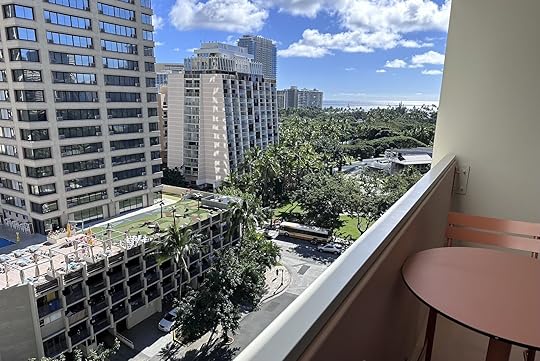
Photo: Alex Bresler
Staying at the Romer Waikiki showed me a different side of the island than I expected after an otherwise beginner-surf-focused trip to O’ahu. But I think that’s the point. And with rates starting at $208 per night, I’d say it’s a pretty good deal considering that the hotel’s greatest amenity is providing insider access to the rest of O’ahu. 
The Most Convenient Airbnbs Near Ha Long Bay, Vietnam
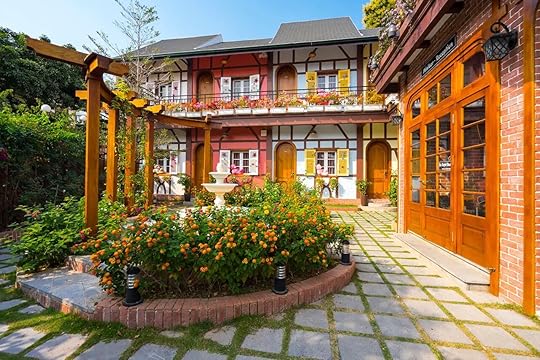
Around 1,600 towering karst pillars and forested islets spring from the emerald bays off Vietnam’s northeastern coast. Traditional sailing junks, cabin cruises, and yachts drift through the Ha Long, Lan Han, Bai Tu Long bays, and the Cat Ba Archipelago. Most travelers spend at least one night aboard with kayaking, climbing, and short yet steep hikes immersing you further in this spectacular landscape.
In terms of where to stay near Ha Long Bay, the first option is to book an all-inclusive tour with transfers to and from Hanoi. The Vietnamese capital is a three-hour drive from the city of Ha Long and there is a healthy supply of hotels and Airbnbs in Hanoi.
Ha Long is a bustling resort custom-made for visiting the natural wonder with restaurants, beaches, an amusement park, and an international cruise port. Accommodation near the Bai Chay, Hong Gai, and Tuan Chau Island docks is practical for bookending a cruise.
Cat Ba is an appealing place to stay near Ha Long Bay for nature, wildlife, and authentic Vietnamese culture. Besides touring the Lan Ha and Ha Long bays, a national park inhabited by langur monkeys is the centerpiece of this large island. Hiking, climbing, kayaking, and cycling are the best ways to experience the island.
These Airbnbs near Ha Long Bay are concentrated around the lively Bai Chay and the tranquil Cat Ba Island – or directly on the water.
Traveling to Asia? Check out Matador’s gear and accommodations guides: Everything you need in your pack to travel to Southeast Asia These are the best-located Airbnbs in Ho Chi Minh City These Tokyo Airbnbs put you in the heart of this incredible city Experience Singapore’s Coolest Neighborhoods From These Top-Rated Airbnbs Soak in Bangkok’s Epic Skyline From These Airbnbs Across the City These Hong Kong Hotels Offer Luxury and Convenience in the Big City These Hanoi Airbnbs showcase the city’s historic quarters These are the coolest Airbnbs in Laos from Luang Prabang to the countryside These Tokyo Ryokan make for the perfect traditional stay in Japan
We hope you love these Airbnbs near Ha Long Bay! Just so you know, Matador may collect a small commission from the links on this page if you decide to book a stay. Listed prices are accurate as of the time of publication.
Luxury Airbnb with a spa near Ha Long Bay Photo: Airbnb
Photo: Airbnb Photo: Airbnb
Photo: Airbnb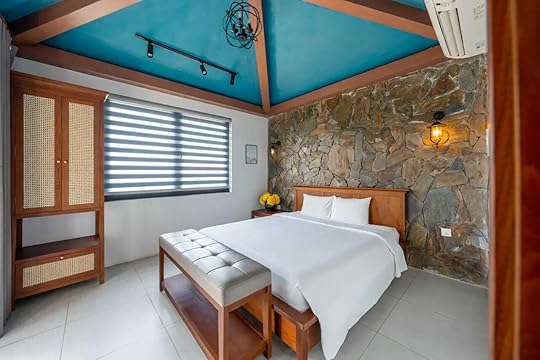 Photo: Airbnb
Photo: Airbnb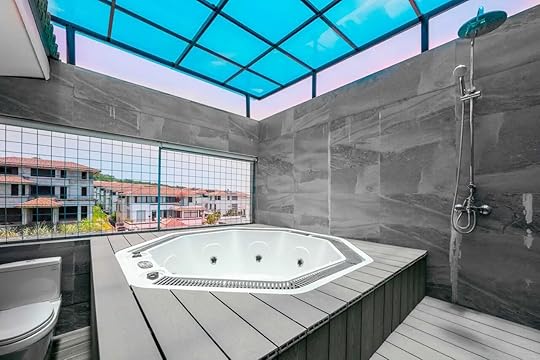 Photo: Airbnb
Photo: AirbnbSee more photosEase yourself into vacation mode at this large villa near Hong Gai Harbor. Panoramic windows allow the natural light to circulate while the hot tub suite is partially open to the elements. Wellness-minded travelers will appreciate two other deluxe bathtubs perfect for unwinding with a book. The kitchen is fully-equipped and there’s a garage for parking rental cars or motorcycles.
Eight guests, four bedrooms
Price: $125 per night
 Photo: Airbnb
Photo: Airbnb Photo: Airbnb
Photo: Airbnb Photo: Airbnb
Photo: Airbnb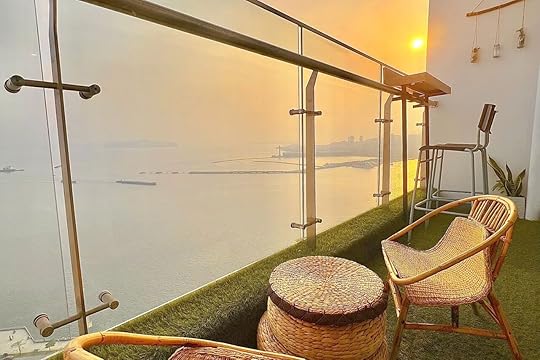 Photo: Airbnb
Photo: AirbnbSee more photosJust across the water from Bai Chay and the cruise terminal, this Hong Gai Airbnb has million-dollar views over Ha Long Bay. Let the sunrise wake you up naturally and spend a meditative morning on the balcony watching boats come and go. The hanging daybed, rattan trinkets, and warm lighting evoke all the elements.
Two guests, one bedroom
Price: $37 per night
 Photo: Airbnb
Photo: Airbnb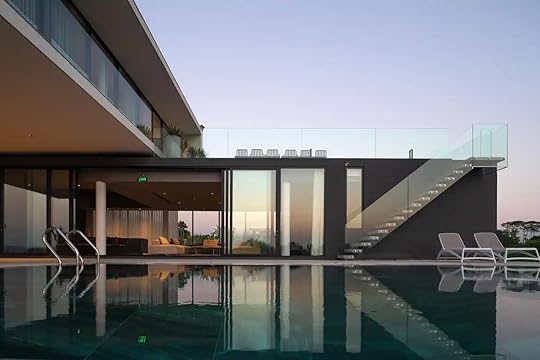 Photo: Airbnb
Photo: Airbnb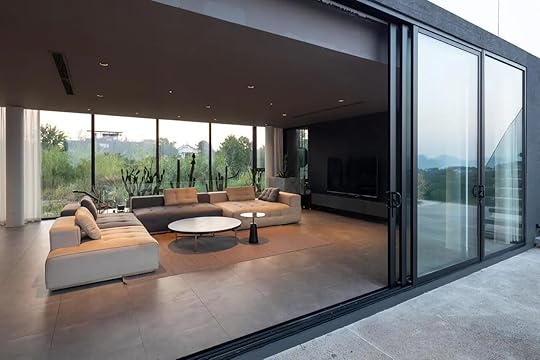 Photo: Airbnb
Photo: Airbnb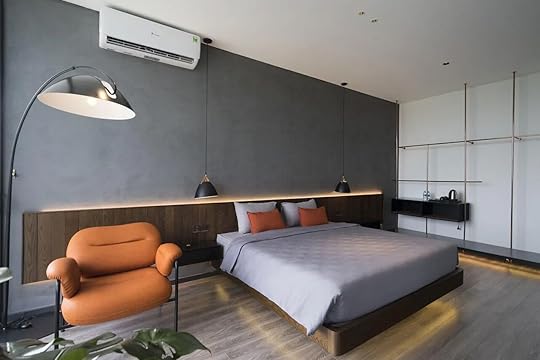 Photo: Airbnb
Photo: AirbnbSee more photosA rare find on the island of Tuan Chau, this cutting-edge villa supplies epic views toward Ha Long Bay and luxury amenities. It has a private swimming pool and staggered terraces to enable guests to spread out. Security and housekeeping are part and parcel whereas private chefs, yacht charters, scenic flights, and transfers are provided upon request.
Fourteen guests, six bedrooms
Price: $556 per night
 Photo: Airbnb
Photo: Airbnb Photo: Airbnb
Photo: Airbnb Photo: Airbnb
Photo: Airbnb Photo: Airbnb
Photo: AirbnbSee more photosThis boutique duplex is handy for Bai Chay Harbor and the Ha Long International Cruise Port. The Little Colmar Homestay is modeled on its namesake French town and wraps around a storybook garden. This is shared with other guests but the apartment is designed for self-catering. Pottery classes take place on the premises and the hosts can help with tours and onward travel.
Two guests, one bedroom
Price: $40 per night
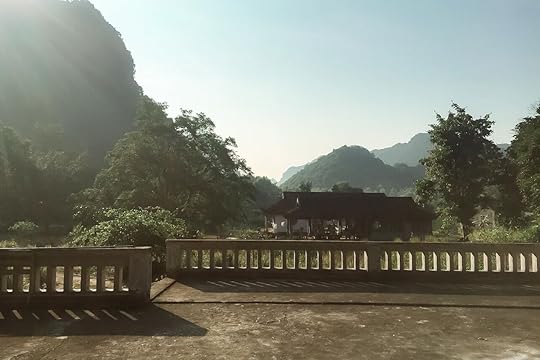 Photo: Airbnb
Photo: Airbnb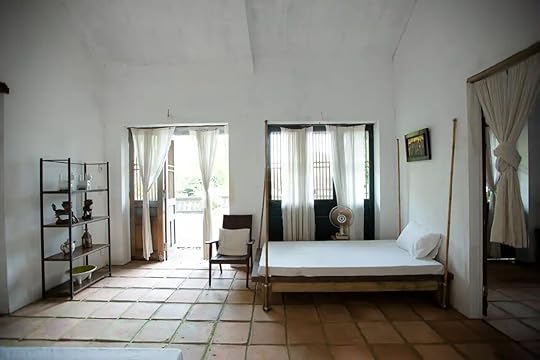 Photo: Airbnb
Photo: Airbnb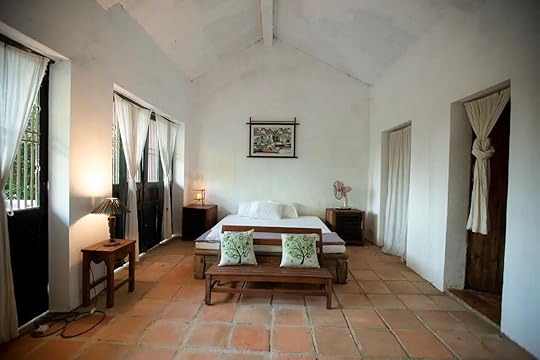 Photo: Airbnb
Photo: Airbnb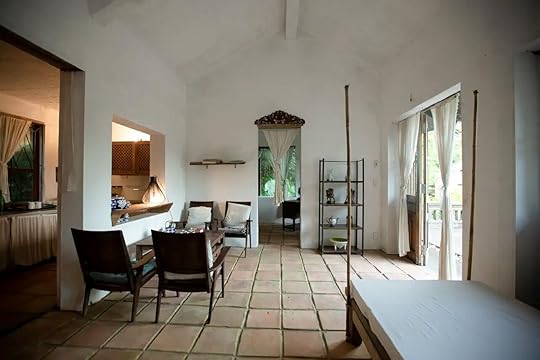 Photo: Airbnb
Photo: AirbnbSee more photosExperience the raw beauty of Cat Ba and the kindness of its residents at the homestay Airbnb on Ha Long Bay’s largest island. The property does require effort to reach although the payoff is a tranquil stay amid the national park and homecooked meals. The unit is simple yet comfortable. You’ll wake up to nothing but the sound of birdsong and the flutter of butterflies.
Five guests, two bedrooms
Price: $65 per night
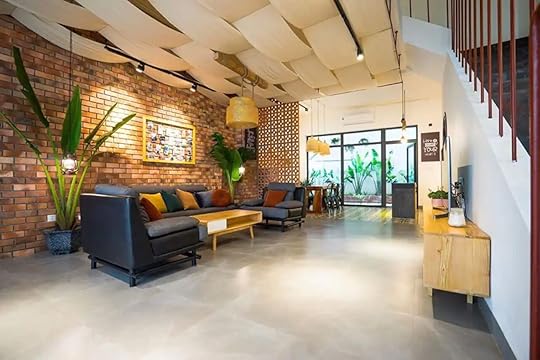 Photo: Airbnb
Photo: Airbnb Photo: Airbnb
Photo: Airbnb Photo: Airbnb
Photo: Airbnb Photo: Airbnb
Photo: AirbnbSee more photosThis beautiful modern home with multiple patios is conveniently located for Bai Chay, Tuan Chau Harbor, and the ferry to Cat Ba Island. The kitchen is well-equipped for cooking and the bedrooms are spacious enough to consider a longer stay. There is a children’s playground close by plus a pool and gym for a small fee. The host can arrange an overnight cruise.
Sixteen+ guests, five bedrooms
Price: $137 per night
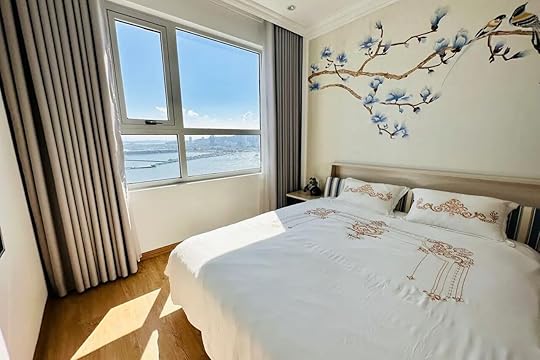 Photo: Airbnb
Photo: Airbnb Photo: Airbnb
Photo: Airbnb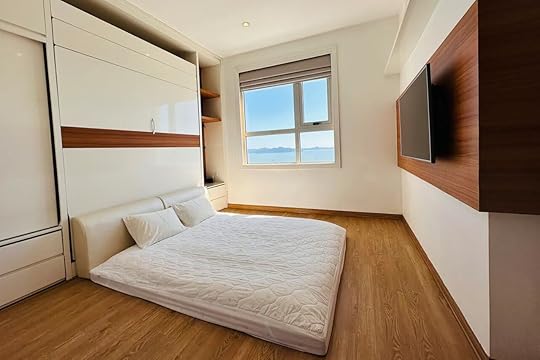 Photo: Airbnb
Photo: Airbnb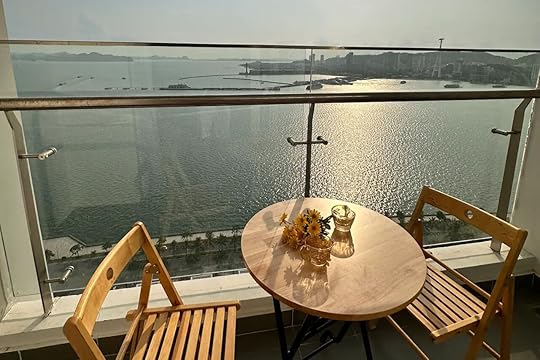 Photo: Airbnb
Photo: AirbnbSee more photosMinutes from Tran Quoc Nghien Temple, this Hong Gai Airbnb offers refuge from the busy tourist center. The minimalist decor diverts your full attention to the sea views which are truly magical at sunset. There’s a kitchen and laundry facilities – which you’ll appreciate after a day in the water. The Superhost is available to help arrange boat trips and other activities locally.
Six guests, two bedrooms
Price: $38 per night
 Photo: Airbnb
Photo: Airbnb Photo: Airbnb
Photo: Airbnb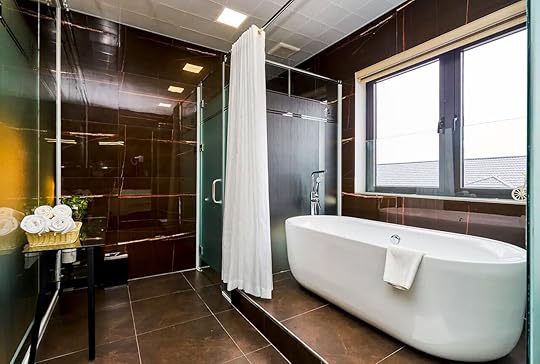 Photo: Airbnb
Photo: Airbnb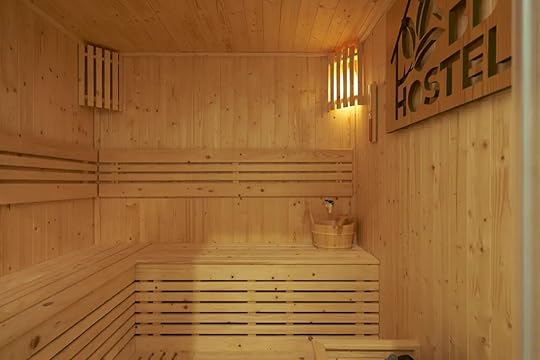 Photo: Airbnb
Photo: AirbnbSee more photosThis contemporary hostel near Ha Long Bay is available for exclusive hire on Airbnb. The property manager is on hand to arrange tours and local tips. All bedrooms are made up as double or twin rooms and work out as having a private bathroom each, making this an epic pick for families or friendship groups. The hot tub and sauna are onsite and the infinity pool is a short walk from the property.
Sixteen+ guests, eight bedrooms
Price: $166 per night
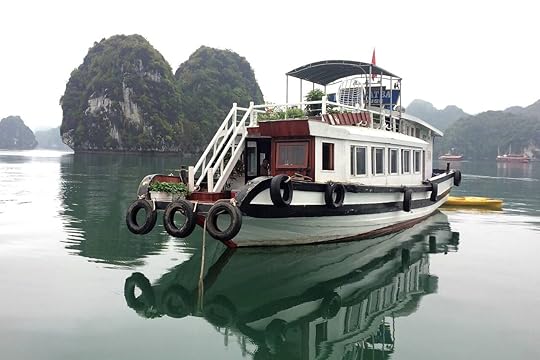 Photo: Airbnb
Photo: Airbnb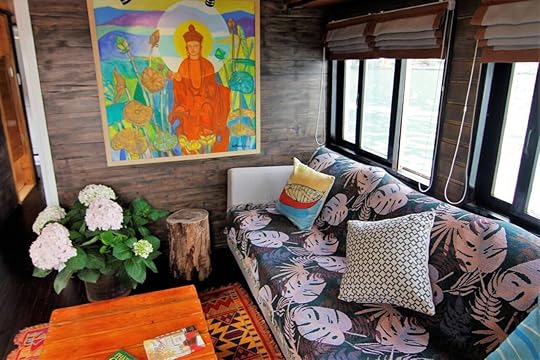 Photo: Airbnb
Photo: Airbnb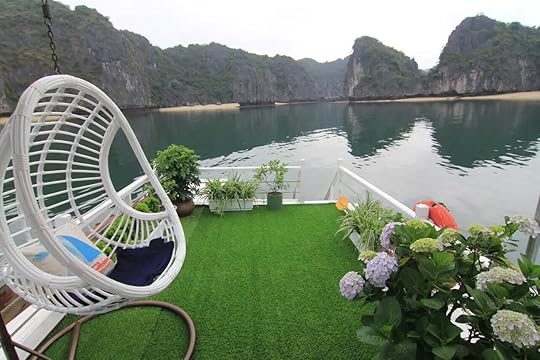 Photo: Airbnb
Photo: Airbnb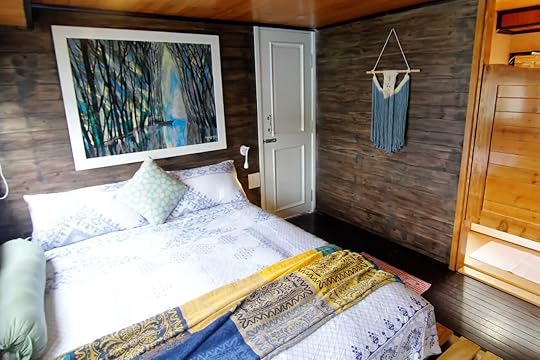 Photo: Airbnb
Photo: AirbnbSee more photosThis floating home is available for private charter and comes with a captain to navigate the limestone bays. After boarding at Ben Beo, you’ll paddle kayaks through Lan Ha Bay and cruise past floating villages and formidable islets. Take in the scenery (and the stars) from the cozy cabin or on the landscaped deck. Breakfast is included whereas a seafood supper is an optional extra. Otherwise, you’re welcome to cook in the boat’s kitchen.
Two guests, one bedroom
Price: $258 per night
 Photo: Airbnb
Photo: Airbnb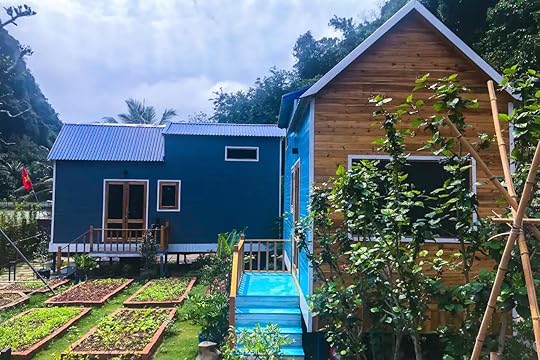 Photo: Airbnb
Photo: Airbnb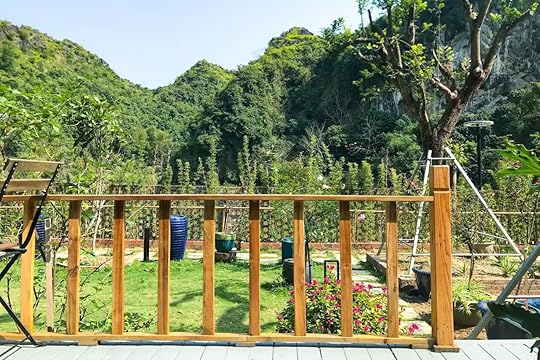 Photo: Airbnb
Photo: Airbnb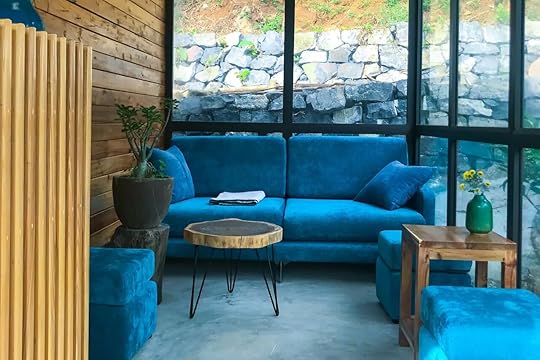 Photo: Airbnb
Photo: AirbnbSee more photosThis wholesome bolthole is only a mile from Cai Bao Harbor and the floating villages. It’s furnished with a loft bedroom, private bathroom, and den although if you sit out in the backyard oasis you’ll earn the company of the resident dogs and cats. The hosts provide a complimentary breakfast and offer Vietnamese coffee and scooter/bicycle rentals. A grounding experience between cruising the bay and roaming Hanoi Old Quarter.
Two guests, one bedroom
Price: $45 per night
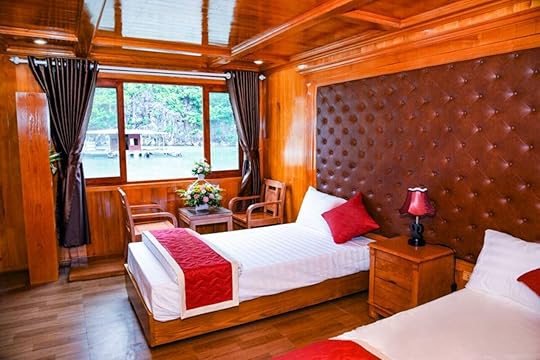 Photo: Airbnb
Photo: Airbnb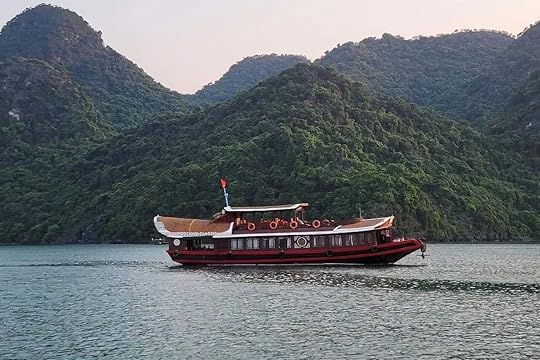 Photo: Airbnb
Photo: Airbnb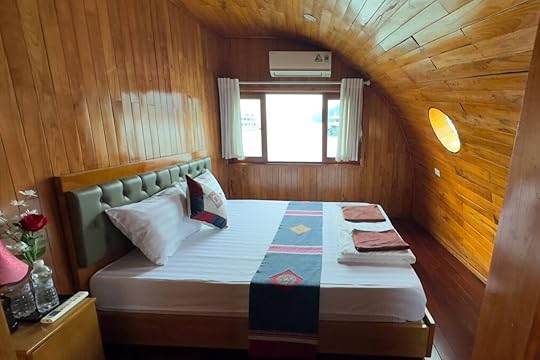 Photo: Airbnb
Photo: Airbnb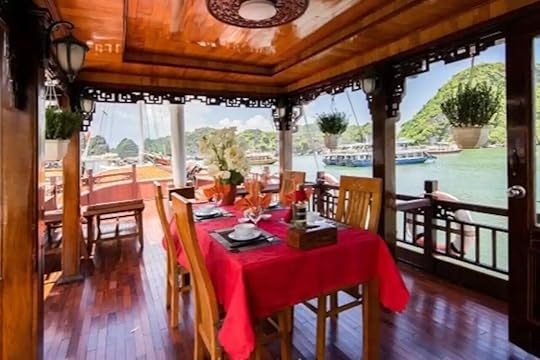 Photo: Airbnb
Photo: AirbnbSee more photosAvoid small talk with strangers and book this exclusive junk boat overnight Airbnb experience in Ha Long Bay. The ship sets sail from Ben Beo on Cat Ba Island before stopping for snorkeling, swimming, kayaking, and biking excursions. Dinner is included in the nightly rate which means you can give your full attention to the onboard karaoke booth or learn how to fish for squid.
Ten guests, three bedrooms
Price: $286 per night
February 5, 2024
8 Fascinating Black History Sites Around the World
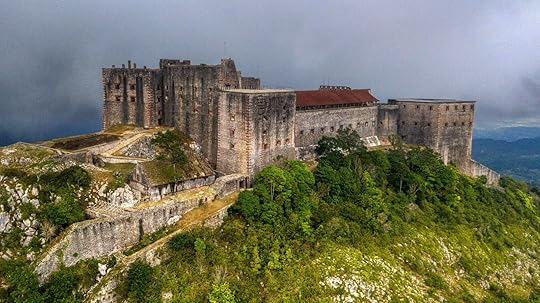
Black History Month is a time reserved annually to celebrate the rich tapestry of global cultures, milestones, histories, and contributions made by Black people. While the month of February typically recognizes African Americans’ specific triumphs and breakthroughs in US history, many stories of Black history have roots in nations that precede many pivotal moments in the history of the United States. And many countries around the world are home to destinations and sites that echo the resilience, creativity, and enduring legacy of the African diaspora.
From vibrant villages near Cartagena to historic sites in West Africa and the Caribbean, many places worldwide have preserved structures in places that encapsulate the essence of Black heritage and stories.
The eight locations below are meaningful stops in popular tourist countries, all offering insight into the socio-political aspects of Black history. A visit to any of the sites below is not just interesting, but also a way to connect with and learn more about Black history well beyond the borders of the United States.
Here are eight Black history sites around the world that celebrate the struggles, achievements, and culture of Black citizens.
Elmina Castle in Elmina, Ghana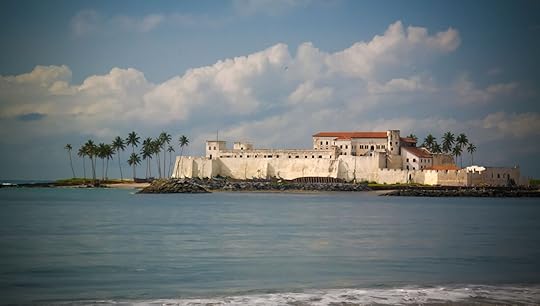
Elina Castle sits about three hours south of Accra. Photo: Homo Cosmicos/Shutterstock
Located in the coastal town of Elmina in Ghana, Elmina Castle is a historic site that holds the tragic stories of the transatlantic slave trade and European colonialism in Ghana.
Constructed by the Portuguese in 1482, the castle was initially designed as a trading post for commodities like gold. Later, colonizers came to see indigenous Ghanians as commodities, and held captured slaves at Elmina Castle. There, they were tortured and sold, explaining why the site is also called a dungeon.
The castle is now recognized by UNESCO as a World Heritage Site and attracts visitors from all over the world. On tours, visitors can learn about the history of the slave trade in Ghana, entering the rooms where enslaved people were once held. It’s a somber site, but also plays a role of utmost importance in explaining why structures like Elmina Castle must continue to be preserved.
Address: 3MM2+4R3, Elmina, GhanaHours: 9 AM-4:30 PM dailyCosts: 50 GHS (about $4)Apartheid Museum in Johannesburg, South Africa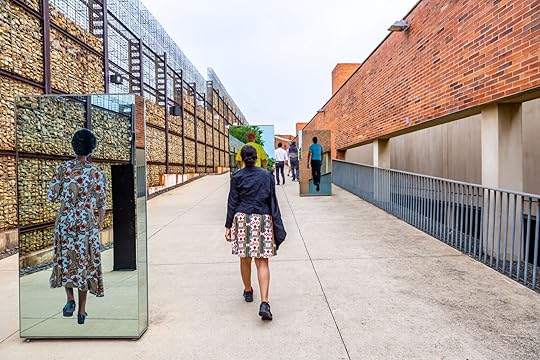
A woman at the Apartheid Museum’s entrance. Photo: Finn stock/Shutterstock
The Apartheid Museum in Johannesburg stands as a powerful testament to South Africa’s past and the struggle against institutionalized racial segregation. It was a period in the country’s history when racism was legal and the minority white population did all it could to keep Black citizens disenfranchised and without any kind of equal rights.
Apartheid in South Africa lasted from 1948 to the early 1990s, and the museum takes visitors on a journey through the period with compelling exhibits that chronicle the system’s origins, impact on individuals and communities, and formal dismantling.
The Apartheid Museum uses examples such as its race classification entry system that classifies visitors as white or non-white to immerse them into the realities of life under the system. The legacy of the anti-apartheid struggle remains a powerful reminder of what Black individuals have overcome in the face of systemic injustice, and why continuing to fight for equality will always matter.
The museum is also only 15 minutes from the home of former South African President Nelson Mandela in the neighborhood of Soweto. It’s one of the most important Black history sites in Africa, and maybe the world, as Mandela was the country’s most famous freedom fighter and political prisoner.
Address: Northern Parkway and Gold Reef Road, Johannesburg, 2001, South AfricaHours: 9 AM-5 PM, Wednesday-Sunday. Closed Monday and TuesdayCosts: R100-150 (about $5.50-$8)The Black Cultural Archives in London, UK
The facade of London’s large Black Cultural Archives. Photo: William Barton/Shutterstock
Nicknamed the “Home of Black British History,” the Black Cultural Archives (BCA) in London is an institution devoted to collecting, preserving, and commemorating the histories of individuals of African and Caribbean descent in the UK.
The Black Cultural Archives was formed as a result of a series of unfortunate and unjust events toward Black people in the UK, including the New Cross Massacre in 1981 in which 13 Black people were murdered by a far-right group. The BCA has exhibitions, events, and educational programs, and supports the preservation of other Black historical sites around London.
Address: Northern Parkway and Gold Reef Road, Johannesburg, 2001, South AfricaHours: 9 AM-5 PM, Wednesday-Sunday. Closed Monday and Tuesday.Costs: R100-150 (about $5.50-$8)Citadelle Laferrière in Cap Haitian, Haiti
Guests can ride horses or hike to thee hilltop fortress. Photo: Rotorhead 30A Productions/Shutterstock
Haiti’s achievement of independence in 1804 was a monumental and empowering moment in Black history. As the first Black republic and nation to have a successful slave revolt, Haiti has undeniably played a critical role in history. Its success in 1804 inspired several other nations to work toward independence and human rights globally. And Citadelle Laferrière in Cap-Haitian is a site that represents Haiti’s struggle for freedom. Built after the revolution, the mountaintop fortress was constructed to defend Haiti’s newfound free citizens from possible French invasion.
Today, at the bottom of the mountain, dozens of horses await to take tourists to the fort’s entrance. It’s the starting point for tours of the structure, looking at both the construction and architecture as well as the history of the revolution that inspired several independence movements to come.
Address: HQF4+4H3, Vaseux, HaitiHours: 8 AM-4 PM dailyCosts: Horseback rides are about $15, admission is $5San Basilio de Palenque in Colombia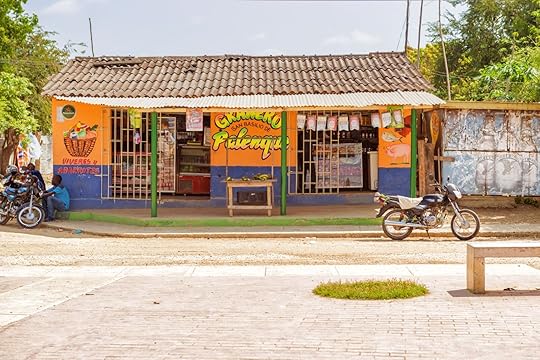
Walking tours through the town are a popular activity for visitors to Cartagena, Columbia. Photo: Marek Poplawski/Shutterstock
San Basilio de Palenque, commonly referred to as “Palenque,” is the first free town in the Americas. It was founded in the 17th century as a refuge by escaped slaves.
Residents of the town have preserved many of their historical ties to Africa through social, medical, cultural, and religious practices. And visitors who make the trip can learn about the history firsthand from the inhabitants themselves.
The village is known for its vibrant music, dance, and creole language, making it a living cultural treasure with deep roots in the African diaspora. The best way to visit the town is on a day tour from Cartagena, about an hour away. On tour booking sites like Viator, you’ll find guided trips like this freedom tour or this historical tour, most of which include a visit to the town’s museum and chances to watch local dancers and meet musicians playing traditional songs.
Palenque is a beautiful example of a town that maintains its unique Afro-Colombian culture, blending African traditions with Colombian influences.
Address: Palenque, ColombiaHours: N/ACosts: Free to visit, tours start around $110 per personAfro Brazil Museum in São Paulo, Brazil
The museum is the worth at least a half-day visit. Photo: lucianospagnolribeiro/Shutterstock
Brazil’s Afro culture is strong and vibrant, proving the enduring legacy of the country’s many Black citizens. Afro culture is a huge part of the country’s cultural mosaic – a mosaic visitors can further explore at the Afro Brazil Museum in São Paulo.
The museum contains more than 6,000 pieces of art ranging from paintings to ethnological pieces by Brazilian and other creators worldwide from countries like Cuba and Haiti. Its six sections include “Africa: Diversity and Permanence,” focused on the many cultures of Africa; “Work and Slavery;” “Afro-Brazilian Religions,” about the many spiritual belief systems in the country rooted in Africa; “The Sacred and the Profane,” teaching about Brazilian festivals; “History and Memory,” about Black contributions to history and society; and “Visual Arts: the Afro-Brazilian Hand,” all about Brazilian art and creativity.
Address: Portão 10, Av. Pedro Álvares Cabral, s/n – Vila Mariana, São Paulo – Estado de São Paulo, 04094-050, BrazilHours: 10 AM-5 PM, closed MondaysCosts: R$15,00 (about $3.30)The ‘Door of No Return’ in Ouidah, Benin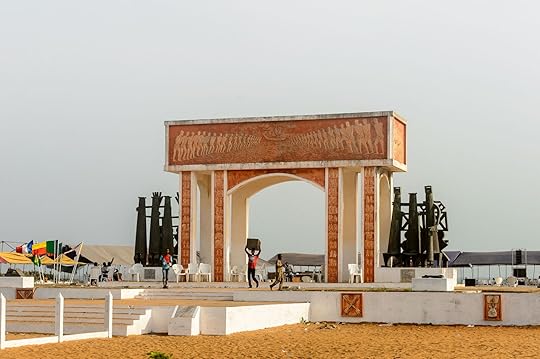
One of a few “door of no return” monuments is just south of Ouidah, Benin. Photo: Anton_Ivanov/Shutterstock
The term “Door of No Return” is typically associated with one of several locations along the West African coastline used as departure points for enslaved Africans during the transatlantic slave trade. These symbolic doors, usually in forts or slave dungeons, represented the final passage away from home as enslaved individuals were forced onto ships, unlikely to ever return.
The Door of No Return in Benin is a colorful archway monument on the coast of Ouidah. The arch depicts chained enslaved people as they walk to the sea to board ships to carry them away from Africa. It’s thought that Europeans forced nearly 1.6 million people into slavery from the Bay of Benin, in the modern-day countries of Benin, Togo, Ghana, and Nigeria
The site stands as one of many reminders of the transatlantic slave trade. It’s been known to elicit an emotional response from visitors as they stand in the same space where enslaved people once began their forced journeys abroad. It’s only about a 10-15 minute taxi ride from the town of Ouidah, near the town’s popular beaches.
Address: On the beach, roughly three miles south of OuidahHours: N/ACosts: FreeMuseum of Black Civilizations in Dakar, Senegal
The Museum of Black Civilizations in the largest in Senegal. Photo: Pierre Laborde/Shutterstock
Senegal’s Museum of Black Civilizations opened in 2018 and was designed to both showcase the history of the continent’s various heritages, and unite people to celebrate Blackness. The museum has collections of artifacts, artwork, and historical exhibits highlighting Black civilizations across Africa and the greater global diaspora. Interestingly, the museum is quite large – the largest in the country, actually – but has plenty of empty space. That’s because Senegalese (and other African) groups are leading promising efforts to have stolen artwork and historical pieces returned to the continent. Much of the work now in countries like France and the UK was stolen from African countries during their periods of European colonization.
The museum serves as a crucial platform in Senegal for understanding Black cultures and reshaping narratives about Africa, and is fascinating for both art fans and history buffs. 
A Los Cabos Resort’s $600,000 ‘Billionaire Buyout’ Lets Guests Have the Entire Property and Amenities To Themselves
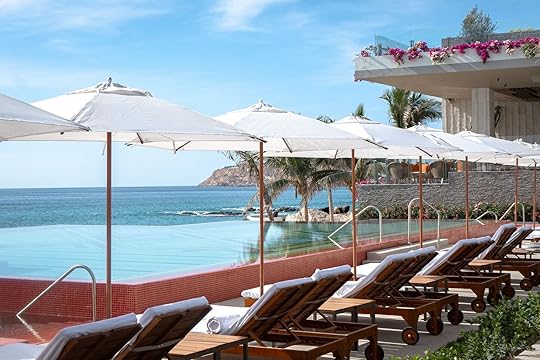
There’s luxury travel that the average person can save up for and splurge on, and then there’s the type of luxury that only the super rich can afford, like having an entire resort to yourself. The newly opened, 79-suite Grand Velas Boutique Los Cabos is making the latter possible for anyone who has $600,000 to spend on a three-day vacation. And it’s all thanks to TikTok.
It all started with a set of viral TikToks that user @freedom_hustlers posted about his and his wife’s stay at the resort soon after it opened. Over a series of videos, he showed how it appeared that they were the only guests on the whole property for the majority of their stay.
@freedom_hustler Replying to @ FULL SERIES IN ORDER ALONE ON RESORT #freedom #babymoon #ivf #neveralone #resort #abandoned ♬ original sound – FREEDOM HUSTLER
At first, the couple thought it was a bit creepy. But by the end they said they felt “so lucky.” Turns out that they were able to experience the resort and all of its amenities without other guests because it was still in the early days of opening (and got to do so for the normal rates).
“During the soft opening phase of the resort, we chose to limit the number of suites available for booking for an intentionally exclusive experience,” Andreas Schmidt, Managing Director of Grand Velas Boutique and sister property Forbes Five Star Grand Velas Los Cabos, said in a statement. “Velas Resorts prides itself on offering the very best, not just in service, but also in food, accommodations, design, and experiences, so we opted for a gradual ramp up of the number of guests to ensure a vacation that surpasses expectations for any travelers who choose Velas Resorts whether they are our first guest or a repeat visitors years after opening.”
Grand Velas is playing off the experience with its Billionaire Buyout package. During the three-night stay, guests can experience a range of top-class amenities and have the resort to themselves:
Private helicopter arrivalGuests can choose from any of the 79 spacious suites with many in-room amenities like a jacuzzi, plunge pool, and moreGuests can dine at a restaurant run by chef Sidney Schutte, who has run a Michelin two-star restaurant, and experience a 10-course menu and wine pairingOther food options include a private beach dinner and a 20-foot breakfast buffetTake a journey on many different activities and adventures like whale watching, beach sports, tequila tasting, and morePrivate sunset cruise aboard the resort’s 55-foot yachtA memorable departure just like @freedom_hustler’s with waves from the entire hotel staff and a Mariachi bandDuring the stay, not only are guests taking part in the activities above, but they also have the luxury to switch and stay in a different room each night, and the hotel staff will pack and unpack your belongings each night.
The adults-only Grand Velas Boutique Los Cabos opened in January 2024 and is the sister hotel of Grand Velas Los Cabos (the company’s third in Los Cabos). A stay like this, however, is unique to the newest property. 
Limelight Hotels Made Me Fall in Love With Après-Ski Again
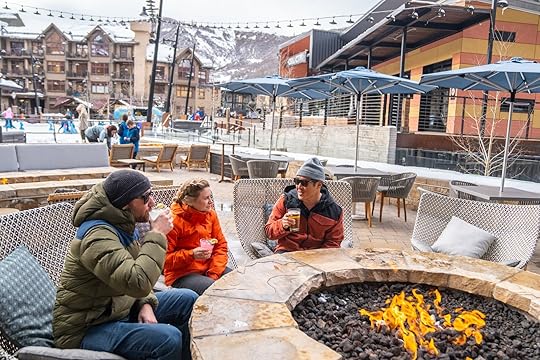
What ski culture in the US has historically lacked is the idea of community-based après-ski activities. In the US, après-ski is usually no more than grabbing a drink in the ski lodge bar, and lacks the kind of scale and excitement that makes it a vital part of the ski day, as you’d find in the Alps.
But the Limelight hotels brand, with locations in Colorado’s Aspen, Snowmass, and Denver, as well as Ketchum in Idaho, seems like it’s bringing that true après-ski culture to some of America’s poshest ski towns. And the hotels’ bars and lounges, comfortable rooms, and shared social spaces seem to be resonating with guests, as more locations are in the works. The brand’s growing success proves at least one thing: ski travel is far from cheap, but if you actually get the experience you pay for, you’re likely to return again and again.
I’ve stayed at both the Limelight Aspen and Limelight Snowmass hotels, attended a work event at the Denver location shortly after it opened in 2023, and recently revisited the Limelight Snowmass after a day on the mountain. Each time I’ve stayed at a Limelight property, I’ve been glad to be there rather than an Airbnb, a high-end resort, or a timeshare. (Quick aside: if you ever find me in a timeshare, it’s a sure sign that I’ve been kidnapped. Please call for help).
View this post on Instagram
A post shared by Limelight Hotels (@limelighthotel)
The reasons I love Limelight hotels, and what makes the brand my ski-town hotels of choice, are subtle. They don’t jump out at you until right away, but once you notice what makes them special, it’s impossible not to appreciate the thoughtfulness. And I’m not the only one who thinks that — here’s why the Limelight properties are becoming the go-to resort of choice for fans of meaningful, enjoyable après-ski.
We hope you love Limelight hotels! Just so you know, Matador may collect a small commission from the links on this page if you decide to book a stay. Listed prices are accurate as of the time of publication.
Bringing ski culture into a polished hotel brand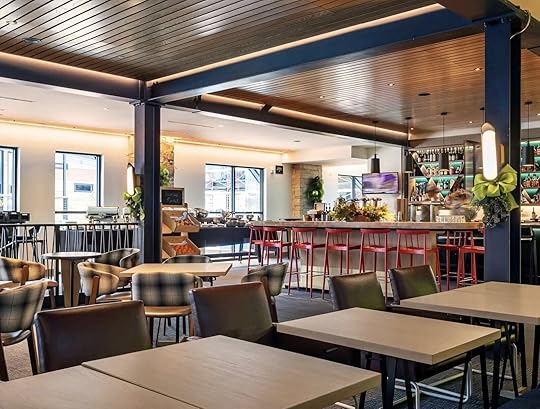
Limelight hotels have plenty of space foe socializing. Photo: Vio.com
Zooming out, Limelight hotels have broken down any pre-imagined barrier to staying in a typical hotel on a ski trip. Hotels have boot and changing rooms and plenty of space in each for everyone to dry out their soggy ski gear, and no one will look at you funny as your boots click-clack through the halls. Its locations in Aspen and Snowmass set the bar for the brand, and the newer locations in Denver and Sun Valley (as well as forthcoming expansions) continue to provide high levels of comfort, cleanliness, and culture without the highest price tag in town, capitalizing on the growing appetite for exciting and high-end ski lodging that isn’t a grand per night.
Limelight Aspen, the brand’s first location, is built on the site of the storied Limelite Lodge and Ski and Spur Bar. It replaces but still honors the former pub, which helped to develop Aspen’s iconic counterculture (Hunter S. Thompson ran for sheriff of Aspen in 1970, representing his self-made “Freak Power” political party). It also sits just a short walk from the Aspen Mountain ski lifts. And while the brand is owned by Aspen Ski Co., but don’t let that turn you off.
The company is a leader in sustainability throughout the ski industry and hosts the best Gay Ski Week in the world. There are ways to do Aspen on a budget, and the town itself is a cultural haven to rival major coastal cities, making it a truly international destination. And in this writer’s view, as someone who celebrates the fusion of global cultures, a hotel brand working to accomplish just that without stretching guests’ wallets to the tune of The Little Nell or the Hotel Jerome makes it worth a look.
Rates at the Limelight properties vary widely by season and day. It’s possible to book for as low as $265 per night. Peak-season rates hover above $600 for a room at Limelight Aspen, and can stretch closer to $900. However, traveling in the shoulder season, mid-week, or early and late season knocks a big chunk off of that price.
Even if you do visit in mid-winter, there are ways to get around the sticker price and to get more value out of the dollars you spend. Case in point: booking your room and lift tickets together saves on both. Booking two or more nights can knock hundreds off the single-night rate, and Colorado residents can take an immediate 20 percent off through the hotel’s local’s discount, with that number occasionally reaching as high as 30 percent.
Limelight Hotels went back to the drawing board to create a better après-ski hangout
While the rooms are comfortable, the hotels are designed to get people into shared spaces. Photo: Vio.com
Most skiers, and indeed, most humans in general, can’t afford to buy several rounds at the lodge bar every day of their ski trip. And those old guys playing Dire Straights covers on beat-up guitars in the corner of dusty ski bars haven’t appealed to the ski crowd since at least the 1980s. I’m a Colorado native and have been deeply involved in ski and snowboard culture for nearly three decades. And outside of a few overly-revelrous days back in college at the old Purgy’s Bar at Purgatory Resort, I can count on one hand the number of times I’ve spent more than an hour hanging out at a ski resort’s base after a day on the hill.
The ski resort après scene on this side of the Atlantic isn’t popping off, and never really has been. The reason, I firmly believe, isn’t because American skiers don’t want to be lively and vibrant and dance on the table in their ski boots like Austrians. It’s because there’s nowhere to do it. That’s partially because most resorts will kick guests out the moment their boot hits the top of the table, for fear of being sued.
View this post on Instagram
A post shared by Limelight Hotels (@limelighthotel)
That’s not to say that the Limelight hotels are a beacon call for ragers. The rooms are quiet and insulated, and I heard at least one Dire Straights song played at the Snowmass location a few weeks ago. Instead, the brand built lounges that serve as places for skiers to come together and revel in the day, away from high ski resort prices and corporate vibes. It’s a happy medium between wild après-ski and corporate après-ski, where skiers can lounge on couches around a fireplace with pizza and beers, or hit the dance floor to live music if they’re so inclined. And the lounges are designed to spur random social interactions more naturally than at your typical bar.
“The Limelight Hotel brand was built on the foundation of fostering a sense of community and connection, dating back to the days when it was the Ski and Spur Bar in the heart of Aspen,” Alino Azevedo, the CEO of Aspen Hospitality, told Matador. “Today, as a growing hotel portfolio, we are dedicated to bringing people together and providing a space where guests can engage with each other and the local community.”
The vibrant après scene and lounge-style dining create a happening atmosphere that keeps guests out of their rooms into the evening, in a manner more similar to European ski towns than what you’d find at the typical resort town condo complex or chain hotel in America.
Another issue the brand tackles head-on is “last-mile” transit: getting from the hotel to the lifts. All Limelight hotels are in central locations so guests can walk to ski lifts, additional dining and social options, and public transportation. Even the Denver hotel, in the center of a city increasingly enveloped by suburban sprawl, is adjacent to Union Station. That puts it in the city’s transit hub, near hip restaurants and bars, and a stone’s throw from the train to the airport.
Sure, you can pay to park your car at the hotels – but there’s no need to bother with a car (and that money is better spent in the lounge, anyhow).
So, how about the rooms?
Rooms are comfortable with plenty of places to work remotely. Photo: Vio.com
Limelight hotels have several room types, including standard rooms, luxury rooms, and suites, all with modern amenities such as oversized closets and plush bedding. All hotels have a range of amenities such as gyms, hot tubs, and pools, and many rooms are pet-friendly. Each of my stays was in a “King Deluxe,” the brand’s most basic room type.
I regularly work on my laptop in hotel rooms, in a different location depending on the time of day. In the mornings, I like to work from a desk or table with a decently comfortable chair, which each Limelight room has. In the evenings, I tend to sit in bed, embracing the “lap” aspect of the laptop. That makes me appreciative of Limelight’s use of box-spring mattresses and bulky bed frames, or rather, the lack thereof. The mattresses are comfortable and furnishings are modern. I loathe box springs — so inefficient and bulky, with little-to-no upsides — and appreciate Limelight’s hardwood frames with extra storage space. And the padded headboards are comfortable to lean against when working without immediate back pain.
View this post on Instagram
A post shared by Limelight Hotels (@limelighthotel)
Rooms have Lavazza espresso pods (a good mark above a Keurig), speedy internet, and plenty to browse on the TV. ADA-compliant rooms are ample, with plenty of additional complimentary amenities on-demand, including feather-free bedding; stuff for dogs, kiddos, and babies; and any toiletries you may have forgotten. Of course, there are plush robes in the closet – this is Aspen Snowmass, after all.
Limelight is guilty of succumbing to the “amenity fee” trend, but at least you’re getting something for it here. Ski storage, airport transfers, breakfasts, and even the chance to test-drive the latest Audi models are included as part of the 10 percent add-on to the check.
Limelight hotels make it easy to get to know a destination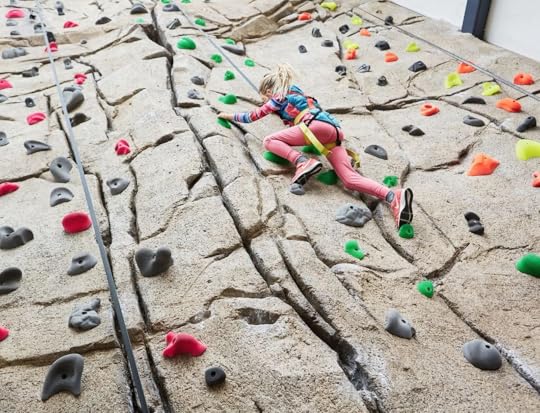
There’s a climbing wall at Limelight’s Aspen hotel. Photo: Vio.com
Hotels in outdoor-centric destinations increasingly incorporate things like climbing walls, partnerships with tour operators for guided hikes and bike rides, and opportunities to connect with like-minded travelers and locals. Limelight offers all of this, but it doesn’t feel like it’s trying too hard. After all, the last thing any ski town needs is another $60-per-plate restaurant named after the local backcountry hut. This, I’m sure, is why Limelight’s Snowmass and Aspen hotels have become the institutions they have.
Would you like to attend a film screening hosted by a local professional rider in the lobby? Yes, I certainly would. How about the ability to demo new gear or get on the lift early? Sign up via the hotels’ Adventures page. The Aspen location even what is perhaps the most iconic mountain town activity of all time: dog portrait day.
I could feel the excitement surrounding the brand each time I stayed at a Limelight property. It seems like it’s successfully positioning itself as the go-to option for travelers seeking hip accommodations without the luxury price point of high-end, ski town hotels. I left each hotel wanting to come back, wanting to be part of the story, because, honestly, it feels hip. And authentic. And trying to fight the increasingly unattainable economic divide that seems to be rising in so many ski towns in Colorado and beyond.
And if you’re someone who regularly takes ski trips and appreciates a good après scene, well, you’ll probably want to go back, too. 
Why a Transatlantic Cruise Could Be Your Next Favorite Vacation
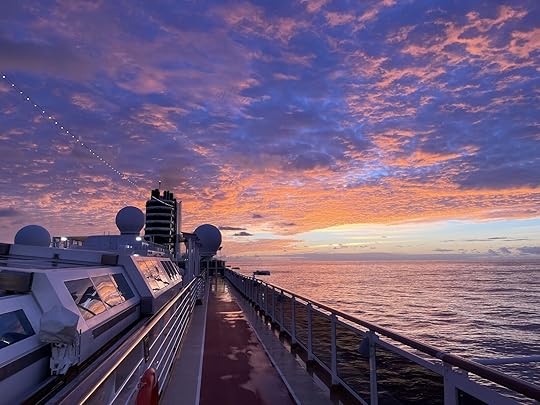
I took my first cruise, a nine-day journey on the Mississippi River on board the American Queen, the world’s biggest paddlewheel steamboat, less than two years ago, in July 2022. Since then, I have been on four more cruises to Alaska, the Mediterranean, around Iceland, and my latest, across the Atlantic Ocean.
I never thought I’d become a keen cruiser, and I especially never thought I’d book myself on a cruise that involved a lot of consecutive sea days, yet, in 2023, I did just that. A great deal found on Holland America’s website led me to book my partner and I on a 14-day cruise from Rome, Italy, to Fort Lauderdale, Florida, from November 26, 2023, to December 10, 2023.
The itinerary consisted of three stops in southern spain: Alicante, Malaga, and Cadiz, as well as one stop in Ponta Delgada in the Azores. It also involved 10 sea days, including seven consecutive ones, while crossing the Atlantic Ocean.
Why choose a transatlantic cruise?The main appeal of transatlantic crossings with major cruise lines like Holland America is the price. In late fall and early winter, cruise lines move several of their ships from Europe to the Americas until late spring when they do the reverse trip. That’s because winter is the best time to sail around the Caribbean and Central America ,while late spring, summer, and early fall are the seasons when cruise lines travel the Mediterranean and Northern Europe. A transatlantic crossing is what is called a repositioning cruise, meaning that the ship departs and arrives at different ports so that it can relocate. Repositioning cruises are usually less attractive and practical to travelers and therefore cost a lot less than closed-loop cruises.
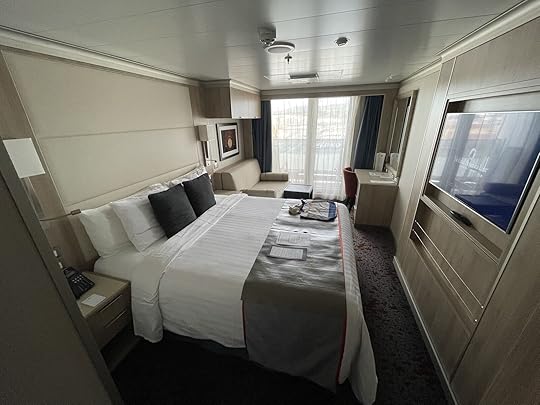
The cabin on our transatlantic cruise with Holland America. Photo: Jesse Adams
Case in point, the journey we took started at less than $300 per person for 14 days in an inside cabin. While that’s not the option we chose, it’s an incredibly appealing price for anyone looking for a cheap vacation. However, depending on where you live, it makes it a little difficult to find affordable flights.
Isn’t it boring to spend so much time at sea? Performance in the World Stage Theater during a translatlantic cruise with Holland America. Photo: Jesse Adams
Performance in the World Stage Theater during a translatlantic cruise with Holland America. Photo: Jesse Adams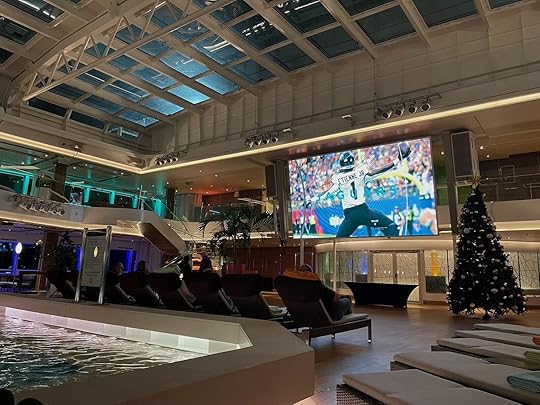 You can even watch NFL games on a big screen during your transatlantic cruise. Photo: Jesse Adams
You can even watch NFL games on a big screen during your transatlantic cruise. Photo: Jesse Adams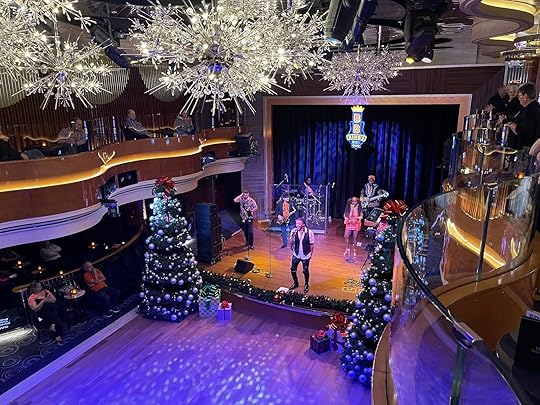 Amazing performance at the B.B. King's Blues Club on Holland America's Nieuw Statendam during a transatlantic cruise. Photo: Jesse Adams
Amazing performance at the B.B. King's Blues Club on Holland America's Nieuw Statendam during a transatlantic cruise. Photo: Jesse Adams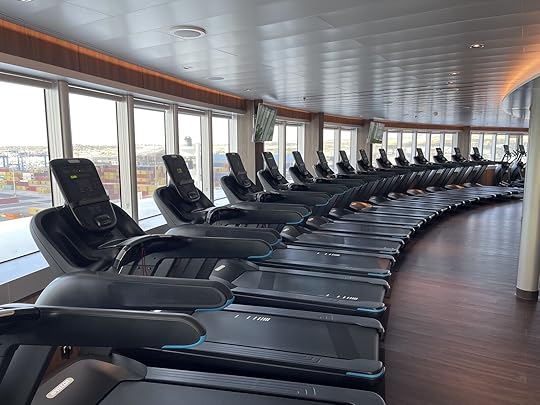 You can keep working out, even if you are in the middle of the ocean. Photo: Jesse Adams
You can keep working out, even if you are in the middle of the ocean. Photo: Jesse AdamsDuring a regular cruise, spending time at sea is a welcome respite from the intense exploring. For me, at least. My partner and I are the type of people who get out of the ship as soon as it docks, walk around the destination all day, and come back just before departure incredibly satisfied, but also totally exhausted. Therefore, a day at sea from time to time is a much-appreciated opportunity to rest and look around the ship, partake in activities, visit the onboard library, and even lounge by the pool.
On a transatlantic cruise, however, there are much more days at sea than days on shore. That means that if your goal is to visit Europe’s nooks and crannies, this isn’t the cruise you want to book. This is the type of cruise you take because you want to rest, eat a lot of amazing food, and spend focused and quality time with your partner, family members, or friends. If you’re traveling alone, or as a couple, it’s also a great way to meet people during the many onboard activities.
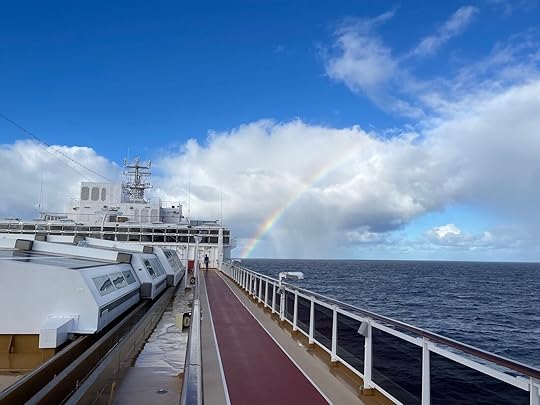
The more time you spend on the running track located on the top deck, the more likely you’ll get to see rainbows over the Atlantic Ocean, dolphins, and more. Photo: Jesse Adams
Because activities abound. From early morning to late night, there’s always something planned, from fitness classes to trivia to wine tastings to movie showings to pickleball tournaments to origami workshops to dance lessons to musical performances, and more — you’d have to be very picky to be bored. Also, if like me and my partner, you just want to be outside as much as possible, you can do that, too. During our trip, we spent hours every day walking on the running track located on the top deck, looking for dolphins, scrutinizing the horizons for other ships, and generally taking in the beauty and peacefulness of the ocean while burning some of the calories we ingested daily.
Transatlantic cruises are a great way to see places you’d never go to otherwiseThe Azores, an archipelago of nine islands located in the middle of the Atlantic Ocean, are so out of the way that they never feature on regular cruises’ itineraries. Cruise ships only stop there when they are crossing the ocean. And that alone is one of the reasons why a transatlantic cruise is a great idea: You get to see places you’d never go to otherwise.
 In the city center of Ponta Delgada, Azores. Photo: Jesse Adams
In the city center of Ponta Delgada, Azores. Photo: Jesse Adams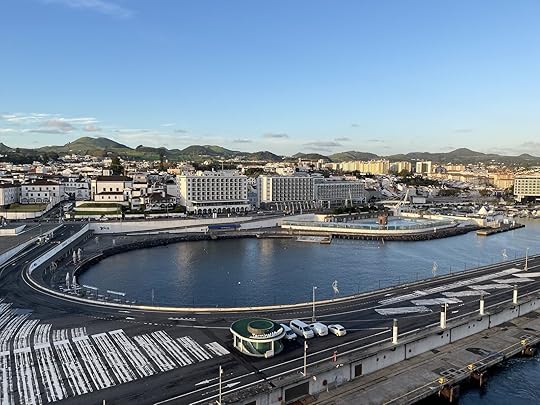 The natural swimming pool in Ponta Delgada, Azores. Photo: Jesse Adams
The natural swimming pool in Ponta Delgada, Azores. Photo: Jesse AdamsThe one day we had in Ponta Delgada, the capital of the Azores and a city on São Miguel Island, was the stop my partner and I most looked forward to. Passengers could book excursions to see the magnificent volcanic lakes, tea plantations, and lush landscapes of this little-known island, but we opted to explore the city and its surroundings on foot. We visited the impressive botanical garden Jardim Botânico José do Canto, toured a tiny pineapple farm and tested out their products at the on-site café, went for a warm December swim among the fish in the outdoor natural swimming pool Piscinas do Pesqueiro, and simply walked around the city to get an idea of how the Azorians live. It was the highlight of our trip.
Don’t you get seasick being at sea for so long?If you’re prone to seasickness, do not book a cruise with multiple consecutive sea days like a transatlantic crossing. Although the captain makes sure to avoid storms along the way, there’s no guarantee that there won’t be big swells for days on end. On our transatlantic cruise, we had beautiful, hot weather and very calm waters throughout, but we could just as easily have been rocked around for seven days straight. And when you’re feeling seasick, there’s nothing worse than knowing you won’t touch land any time soon.
Even if you’re not usually seasick, don’t go on a transatlantic cruise without over-the-counter motion sickness medication. Neither my partner nor I are bothered by seasickness, but we played it safe and brought with us what I call “the miracle remedy”, i.e. Options + Ginger Anti-Nauseant Tablets. It saved us from feeling nauseous (and drowsy) while sailing amid 27-foot swells in Iceland, so we never go anywhere without it.
How about jet lag? Don’t you get super mixed up with the time change?During our 14-day sailing from Europe to the US, we crossed six time zones. Because the ship moved slowly across those time zones, passengers didn’t move back their clocks six hours in one go, instead everyone on the ship moved back one hour every few days, gaining one hour of sleep (and vacation) every time. Multiple announcements were made every time the clocks were turned back, little messages were left in passengers’ cabins to remind them of the change, and all the clocks on the ship were updated before passengers got up in the morning, so nobody got confused about what time it was or got jetlagged. (Note that if you are going from North America to Europe, it is the same process, but you lose one hour of sleep and vacation every few days.)
Isn’t it scary to cross an ocean on a cruise ship?
Sunset over the Atlantic Ocean during my transatlantic cruise with Holland America. Photo: Jesse Adams
Don’t go on a transatlantic cruise if you are claustrophobic or afraid of being at sea for long stretches of time. Being surrounded by nothing but water for multiple days can lead to feelings of anguish and panic, especially if the weather is stormy and the waters are rough. Note that when the weather is too windy or the swells too big, the outside decks are closed, forcing passengers to stay indoors until it passes. Also, don’t make a transatlantic cruise your first ever cruise — try a short cruise with very few sea days before you commit to a long ocean crossing. 
These Airbnbs Showcase Detroit’s History and Bootstrapped Future

Motors and Motown put Detroit on the map. Michigan’s largest city also has a vibrant cultural scene expressed through street murals and a rotating fleet of 75 seasonal food trucks. Served by the free-to-ride QLine Streetcar, Woodward Avenue links Downtown Detroit with Brush Park, Midtown, and the Amtrak station. The Detroit People Mover (DPM) is free for 2024, meaning that you’ll have more dollars to put toward sightseeing – or a place to hang your hat. Featuring skyline condos and artsy lofts, these Airbnbs in Detroit have as much character as Motor City.
We hope you love these Airbnb Detroit vacation rentals! Just so you know, Matador may collect a small commission from the links on this page if you decide to book a stay. Listed prices are accurate as of the time of publication.
Petit Airbnb in the Little Paris of Detroit Photo: Airbnb
Photo: Airbnb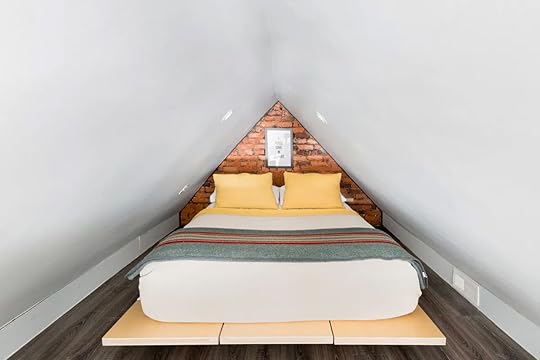 Photo: Airbnb
Photo: Airbnb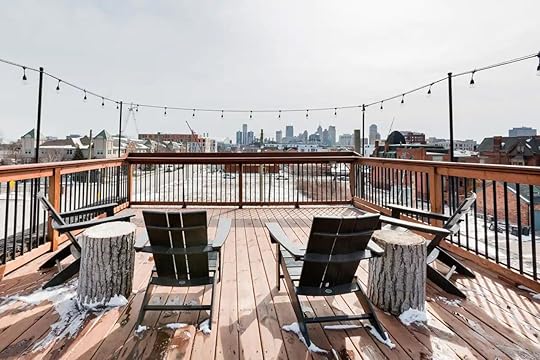 Photo: Airbnb
Photo: Airbnb Photo: Airbnb
Photo: AirbnbSee more photosWedged between Midtown and Downtown, Brush Park has undergone a renaissance since falling into decline during the 1960s. This chic penthouse loft atop an old mansion is beautifully styled with a teal kitchen, designer bathroom, and private roof terrace for lingering over a French press. If you’re not wild about climbing the ladder to bed, check out the Superhost’s other listings.
Four guests, one bedroom
Price: $295 per night
 Photo: Airbnb
Photo: Airbnb Photo: Airbnb
Photo: Airbnb Photo: Airbnb
Photo: Airbnb Photo: Airbnb
Photo: AirbnbSee more photosThe second you drop your bag in this Detroit Airbnb (one of several virtually identical lofts) you’ll consider a permanent move to Michigan. That holy quaternity of industrial-chic decor – exposed brick, concrete counters, hardwood floors throughout, and timber beams – set the tone for a relaxing stay. Market culture is strong in this storied district where vendors flog jewelry, flowers, and street eats in summer.
Six guests, two bedrooms
Price: $464 per night
 Photo: Airbnb
Photo: Airbnb Photo: Airbnb
Photo: Airbnb Photo: Airbnb
Photo: Airbnb Photo: Airbnb
Photo: AirbnbSee more photosA hotbed for culture and the arts, Midtown unfurls on the western side of Woodward Avenue yet offers a quieter environment than Downtown. This three-story Detroit Airbnb is perfect for a pair of couples or a family. The office doubles up as a third bedroom and the master bathroom has a spa tub. There’s room for two cars in the garage and a cute balcony for morning coffee.
Six guests, two bedrooms
Price: $322 per night
 Photo: Airbnb
Photo: Airbnb Photo: Airbnb
Photo: Airbnb Photo: Airbnb
Photo: Airbnb Photo: Airbnb
Photo: AirbnbSee more photosLodged in a former bank in the heart of the city, this modern condo is right on the money. The open-concept lounge and kitchen enjoy natural light and a bird’s eye perspective over the Campus Martius. Both bedrooms have ample closet space and a work desk making it one of the best rentals for a longer stay. Parking is available at an additional cost but a car isn’t necessary.
Six guests, two bedrooms
Price: $243 per night
 Photo: Airbnb
Photo: Airbnb Photo: Airbnb
Photo: Airbnb Photo: Airbnb
Photo: Airbnb Photo: Airbnb
Photo: AirbnbSee more photosThe Detroit Airbnb that everyone’s talking about is located in a Quonset hut in Core City. It’s a tardis – the interiors are far roomier than you might expect. A cozy bedroom roosts at the rear while a light-filled lounge and kitchen claim the front. The unit has a plywood core and all other materials are natural. Any art or trinkets are plucked from local galleries and stores.
Two guests, one bedroom
Price: $119 per night
 Photo: Airbnb
Photo: Airbnb Photo: Airbnb
Photo: Airbnb Photo: Airbnb
Photo: Airbnb Photo: Airbnb
Photo: AirbnbSee more photosFrom the tiniest to the largest Airbnb in Detroit: gather your 30 closest friends and rent out this entire hostel in Corktown. It’s divided into a mix of dorms and double bedrooms with three kitchens and four bathrooms. You’ll also have free reign of the backyard and covered patios. Communal areas honor local landmarks and global travel – remember to mark your hometown on the map.
Thirty+ guests, eight bedrooms
Price: $1,000 per night
 Photo: Airbnb
Photo: Airbnb Photo: Airbnb
Photo: Airbnb Photo: Airbnb
Photo: Airbnb Photo: Airbnb
Photo: AirbnbSee more photosOne block from RiverWalk and a 15-minute walk from Downtown, this elegant coach house sits alongside Trowbridge House – the oldest building in Detroit. The game room has foosball, shuffleboard, and darts. Evenings may be spent sipping wine in front of the fire or watching boats drift past the patio. That’s if you haven’t scored tickets to a game or concert!
Six guests, two bedrooms
Price: $280 per night
 Photo: Airbnb
Photo: Airbnb Photo: Airbnb
Photo: Airbnb Photo: Airbnb
Photo: Airbnb Photo: Airbnb
Photo: AirbnbSee more photosThis brick-and-beam dream is installed in a 125-year-old building in Detroit’s coolest neighborhood. It’s all very hipster with vintage bikes hanging on the walls, pendant lighting, and token midcentury furnishings – brownie points for the volume of utensils and toiletries. The downtown center is a 15-minute stroll although you’ll find some of the best places to eat and drink closer to home.
Four guests, one bedroom
Price: $271 per night
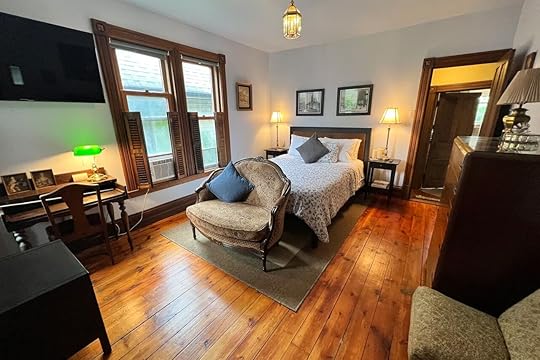 Photo: Airbnb
Photo: Airbnb Photo: Airbnb
Photo: Airbnb Photo: Airbnb
Photo: Airbnb Photo: Airbnb
Photo: AirbnbSee more photosThis eclectic apartment is located in Detroit’s equally “iKlektik” House. Constructed in 1878, the former bed and breakfast has been renovated with mod-cons without disturbing the charm of the original building. Put aside some time for a game of Ms. Pac-Man or a soak in the vintage clawfoot tub and remember to pick up a bottle of liquor to make use of the minibar.
Four guests, two bedrooms
Price: $181 per night
 Photo: Airbnb
Photo: Airbnb Photo: Airbnb
Photo: Airbnb Photo: Airbnb
Photo: Airbnb Photo: Airbnb
Photo: AirbnbSee more photosThis Guest Favorite Airbnb in Detroit is a short stroll from coffee shops and bars including the famed Motor City Brewing Works. If you prefer to cook, the kitchen is stocked with all the necessities. The living quarters are festooned with vibrant pieces of art and woven rugs while midcentury modern furniture keeps things simple. It’s awesome for a couple although the sofa bed is handy for small families.
Four guests, one bedroom
Price: $200 per night
 Photo: Airbnb
Photo: Airbnb Photo: Airbnb
Photo: Airbnb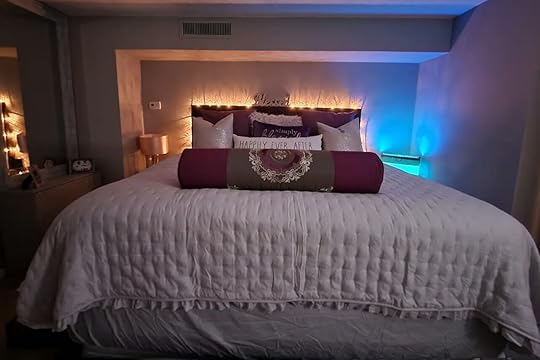 Photo: Airbnb
Photo: Airbnb Photo: Airbnb
Photo: AirbnbSee more photosThis urban haven flies high amid the skyscrapers and is a short walk from Ford Field and Campus Martius. That great hulk of a couch is trumped by two of the comfiest beds in town. Spend evenings jamming on the drums or scoping out the stars with the telescope. Bring bathers in case you fancy morning laps or a session in the shared Jacuzzi.
Four guests, two bedrooms
Price: $1,093 per night
Detroit follows Eastern Standard Time (EST). Michigan switches to Daylight Saving Time (DST) between early March and the first Sunday in November.
What to do in DetroitMost of the things to do in Detroit are clustered around Downtown, Midtown, and the Rivertown District. These are easy to get to
Rejoice in all things Americana and automobile at the nearby Greenfield Village and Henry Ford Museum. This vast open-air museum in Dearborn is dedicated to innovation and imagination with an emphasis on transport – cars and beyond. There are locomotives and horse carriage rides, working farm and mill exhibits, and a Main Street district populated with actors.Stand where Diana Ross and the Supremes, Stevie Wonder, and Marvin Gaye stood in the Motown Records recording studio at the Motown Museum.Immerse yourself in the latest exhibits at the Museum of Contemporary Art and check out Diego Rivera’s Industry Murals at the Detroit Institute of Art.Scope out the street art in Eastern Market. This is where you’ll find the Eminem/D12 mural.Go for a ride on the QLine or Detroit People Mover – both are free.Wave at Canada from the Detroit RiverWalk.Rent a bicycle and explore the lagoons and gardens of Belle Island. There’s an aquarium and maritime history to visit and a gigantic slide to ride.Cruise the Eastern Market. Saturday is for produce, Sundays in summer is for arts and crafts), and Tuesdays in summer is for free yoga and Zumba sessions. The market also hosts regular food truck rallies.Roar for the Detroit Lions at Ford Field. Superstars also perform music concerts in this stadium and Little Caesars Arena, the home turf of the Detroit Pistons and the Detroit Red Wings.Skip the dinner reservation and let your nose guide you to one of Detroit’s 75 (and counting) food trucks. Clustered along Woodward Esplanade, these rotate from June until October. More like thisFood + DrinkAn Ode To Crispy, Super Cheesy Detroit Pizza
More like thisFood + DrinkAn Ode To Crispy, Super Cheesy Detroit Pizza
February 2, 2024
Cancel Your May Plans: There’s a UFO Festival in the PNW

Usually, when most people think of aliens and UFOs, they envision Roswell, New Mexico — site of the supposed 1947 UFO crash that the government claimed was a weather balloon — or perhaps Area 51 in Nevada, a top-secret Air Force base said to be where the US studies and researches aliens. And if you’re a real ET-aficionado, you may even think of a destination like Alaska, where unexplained phenomena seem to be a dime a dozen.
But if you’re the kind of person who normally has your eyes on the skies, you don’t need to go as far north as Alaska to find a UFO: you just need to go to the tiny town of McMinnville, Oregon, a pretty little town about an hour south of Portland. That’s because McMinnville was where the famous “Trent Sighting” UFO photos published in TIME Magazine were taken. And now, every May, the town celebrates its most famous photographs with weekend-long UFO festival celebrating all-things-alien. And it looks like it may be one of the coolest festivals in the PNW.
View this post on InstagramA post shared by McMenamins Pubs & Hotels (@mcmenamins)
Here’s what to know if you’re planning a trip to the McMenamin’s UFO Festival in McMinnville, Oregon.
McMinnville is in Oregon’s famous wine country
Photo: Jess Kraft/Shutterstock
McMinnville sits squarely in the middle of Oregon’s famous Willamette Valley, home to more than 700 wineries. Willamette Valley pinot noirs have won multiple global awards, and it’s generally considered to make some of the best wines in the US. Naturally, the festival incudes plenty of opportunities for food and drink, and most of the events are centered around frivolity, with plenty of on-site vendors. There are also tons of great restaurants and tasting rooms in downtown McMinnville, and swinging by a few of them during the festival weekend is practically a must-do.
The festival is — wait for it — out of this world
Photo: Dee Browning/Shutterstock
Events at the festival are focused on what the organizers call “all things extraterrestrial.” Downtown McMinnville closes to cars on the Saturday of the festival to accommodate the UFO parade, which is on the same day of the pet costume contest. So if you like the idea of sitting in the sunshine, sipping a local beer while watching dozens of dogs dressed like aliens and UFOs walk by (and who doesn’t?), you may want to make plans to go to McMinnville in May.
Other events of the festival include live music, a 5K fun run, and an evening “landing party” at a local bar. Alien costumes are encouraged at all activities, obviously.
View this post on Instagram
A post shared by McMenamins Pubs & Hotels (@mcmenamins)
While the festival certainly doesn’t take itself very seriously, it does have some lectures and seminars that dive deeper into the science of extraterrestrials and possibility that life does exist on other planets. Past festival speakers include Earl Grey Anderson, a professor of UFOlogy and chapter president of MUFON (the Mutual UFO Network); author and physiologist Irena Scott; and award-winning investigative journalist George T. Knapp. There are usually four or five speakers per festival, with a nominal entry fee to the various lectures. There are also moving screenings, dining specials, and plenty of unofficial events associated with festival weekend.
Where to stay at the McMinnville McMenamins UFO Festival
Photo: The Vintages Resort
The festival is co-sponsored by the McMinnville Downtown Association, but the primary sponsor is McMenamins Hotel Oregon. If you’ve stayed at a McMenamins hotel, you’ll understand why sponsoring a UFO festival is a natural fit. The hotels are all unique and quirky, housed in historic buildings with hidden bars and unexpected features. The McMinnville McMenamins (that’s a mouthful) hotel was built in 1905 as a soda fountain and bus depot. Now, it’s a boutique hotel with a rooftop restaurant and and bar themed after a turn-of-the-century magician.
McMenamins Hotel Oregon has only 38 rooms, so if you’re planning to attend the festival, book early.
If McMenamins is sold out, or you want something with a little more space, check out the nearby Vintages Trailer Resort (which seems like a great fit for anyone attending a UFO Festival). Guests of the resort get a voucher for free and discounted wine tastings around town, and with free cruiser bike rentals available to guests, you don’t need to worry about drinking and driving if you decide to buy an alien-themed cocktail or two at the festival.
About the Trent Sighting UFO photos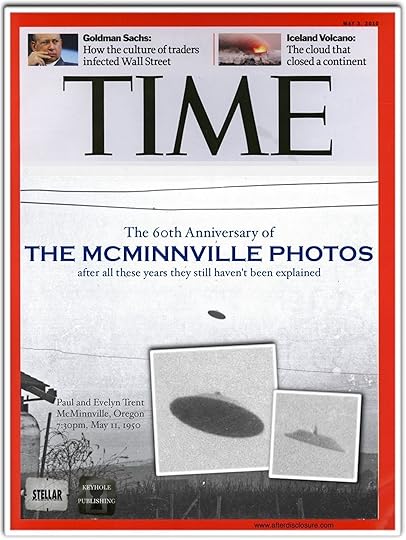
Photo: The Vintages/Time Magazine
The Trent UFO photos are a series of photos taken in 1950 at the Trent family farm in McMinnville. They show a disc-shaped object hovering in the sky above the fields, which many people believe is a UFO. The object was seen by both Evelyn and Paul Trent, and supposedly moved away soon after the photos were taken. They were published in the local newspaper and soon gained national attention after being published in TIME Magazine. The photos have been debated and analyzed by researchers and scholars for decades, but there’s no definitive conclusion as to their authenticity. 
Should You Cancel a Trip Due To a Government Travel Advisory? Here’s What They Really Mean

Travel advisories are kind of like the Pirate Code in Pirates of the Caribbean – more like guidelines than actual rules. We look at them. We furrow our brows and nod and pretend to take them seriously. Then, in all likelihood, we simply book the trip anyway. But it’s undeniable that when it comes to travel safety, we separate destinations into two buckets: less luxurious, more adventurous countries where travel warnings are likely and expected, and standard vacation destinations whose safety we take for granted. When a travel advisory is attached to a country in the latter category, it may give us more pause than usual. That’s why when the United States State Department urged Americans to “exercise increased caution” in the Bahamas recently, it took many by surprise.
According to the advisory, “gang-on-gang violence has resulted in a high homicide rate primarily affecting the local population. Violent crime, such as burglaries, armed robberies, and sexual assaults, occur in both tourist and non-tourist areas. Be vigilant when staying at short-term vacation rental properties where private security companies do not have a presence.”
We might take safety into account when visiting parts of Africa or the Middle East due to political unrest and specific terrorist threats targeted toward Americans, but the Bahamas? The advisory is only a Level 2 – by no means the strongest – and should by no means derail your plans to visit the Bahamas. But it’s a good reminder to really examine what travel warnings are, what they actually mean, and how seriously we should take them.
What are State Department travel advisories?The US State Department’s travel advisory system is a four-tiered ranking of each country based on its safety and security conditions. The point is to help US citizens make informed decisions about travel, based on the perceived safety of the destination.
Countries are ranked with a travel advisory level 1-4 based on their risk to US travelers.
Level 1: Exercise normal precautions
These are the safest countries, where travelers don’t need to take any special precautions. The risks and concerns are considered on par with those travelers would encounter during typical international travel.
Level 2: Exercise increased caution
Countries considered “fairly safe,” though with a higher-than-average chance of disorder. Travelers are encouraged to be more alert and aware of their surroundings.
Level 3: Reconsider travel
These countries may contain threats to travelers’ safety. Those threats could come in the form of terrorism or natural disasters. Exceptionally poor infrastructure might also be an issue.
Level 4: Do not travel
Level 4 really doesn’t mince words. The highest security risk due to life-threatening risks like nuclear terrorism threats, rebellions, war, and bombings, these countries are considered the most dangerous in the world for travelers. If anything were to happen to you during your visit, the US government might not even be able to assist, given limited diplomatic relations or other political issues.
Traveling to a Level 4 country might also complicate your travel insurance. Most travel medical insurance plans will exclude any coverage if you enter into a Level Four Advisory Country,” P.K. Rao, president of INF Visitor Insurance, tells Conde Nast Traveler. Indeed, since Level 4 countries are considered dangerous, insurance companies may also consider them too high risk to offer coverage, though the situation varies by country and insurance type and provider.
For each travel advisory level, you’ll also be able to find specific reasons for the designation. A letter-coded system indicates why the country is considered dangerous (T = terrorism, N = natural disaster, K = kidnapping, etc.).
How seriously should we take travel advisories?Look, everyone should be safe out there. Nothing ruins an otherwise great trip like…you know, getting kidnapped. But at the same time, it’s important to understand that safety – even the State Department’s estimation of safety – is subjective.
There’s undeniably a certain bias in the administering of travel warnings, where Western, first-world nations are more likely to be considered safe (often in spite of their domestic issues), while poorer, non-Western countries are regarded as inherently more unsafe.
“The State Department has a long history as a policymaking agency of the US government,” writes Ryan Larsen in his dissertation, A World of Warning: Exploring U.S. Department of State Travel Warnings and Alerts. He hints that advisories might have underlying political biases and motivations, too. “Countries that do not share the U.S. values of democracy and civil liberty, that is, countries that are autocratic, were chosen as likely having lower regard from the American perspective. Based on these variables, not only did Dependent and Deviant classified countries have more Travel Warnings and Alerts than Advantaged and Contender countries, but they did so overwhelmingly.”
It’s not exactly surprising that the US assigns non-democratic nations stricter travel warnings than political allies, though it does raise the question: are travel warnings true safety indicators, or mere reflections of the geopolitical landscape?
“It is shown that primarily Western, white, Christian, democratic, and economically powerful countries generally do not receive Travel Warnings,” Larsen says, suggesting that this could be intended to shield allies from the negative economic consequences of discouraging travel. “If Americans heed a Travel Warning, they withhold not only their presence in a given country, but their money.”
While many countries don’t advise any extra precautions for visiting the US itself, many do note troubling crime and mass shooting statistics that travelers should be aware of. New Zealand advises its citizens to “exercise increased caution” when visiting the US (level 2 of 4), due to terrorism threats. Violent crime targeting members of minority communities is also cited as a concern. France warns travelers about crime in specific areas, like Boston and Atlanta, and Japan raises the alarm about the possibility of active shooter situations, with advice on how to react.
No one is suggesting that travel advisories are a nefarious instrument of political persuasion. They’re incredibly helpful tools that every traveler should consider before booking a trip, especially if you’re not up to speed on your destination’s safety situation. It is, however, important to remember that advisories are informed by a number of factors, some of wich might be more relevant to your travels than others.
February 1, 2024
13 of the Best All-Inclusive Caribbean Resorts for a Luxury Honeymoon

The first step of planning a honeymoon is creating a quick checklist with your partner. If said list includes sun-filled days, stunning white beaches, azure water, outdoor sports, world-class wellness facilities, and luxury all-inclusive accommodation, you’re on the right track for the Caribbean. Along with the Maldives, Bali, and Mexico, the Caribbean is one of the most popular destinations for a romantic getaway. Because of this, there are a lot of island locations and package deals to choose from. Many opt for an all-inclusive vacation to the Caribbean, and why not? It means you and your loved one can kick back and savor every moment without worrying about extra costs. The all-inclusive honeymoon resorts below offer some of the best romantic packages, personalized service, private accommodations, and amenities. From over-the-water bungalows with plunge pools to extravagant private island retreats, here’s the crème de la crème across the Caribbean.
We hope you love the all-inclusive honeymoon resorts we recommend! Just so you know, Matador may collect a small commission from the links on this page if you decide to book a stay. Listed prices are accurate as of the time of publication.
Spice Island Beach Resort, Grenada
 Photo: Spice Island Beach Resort
Photo: Spice Island Beach Resort Photo: Spice Island Beach Resort
Photo: Spice Island Beach Resort Photo: Spice Island Beach Resort
Photo: Spice Island Beach ResortSet along Grenada’s most beautiful stretch of soft golden sand, Grand Anse Beach, the family-owned and operated Spice Island Beach Resort is an award-winning Caribbean retreat.
The location is peaceful with a backdrop of green hills and palms, but there are excellent restaurants and boutique shops a stroll (or cycle) away. Getting here is also a breeze. The airport is a mere 10 minutes away, so you can relax by the ocean within an hour of landing.
The resort is impeccably run, with outstanding heartfelt hospitality. This is one of the most important elements to consider when planning your honeymoon. It’s (hopefully) going to be the only time you have an experience like this, so making sure your every whim is catered to is vital.
Spice Island has 64 luxurious suites, 17 of which have private pools, and 34 open directly out onto Grand Anse Beach. The more elevated suites are recommended for couples. They grant guests a smidge more privacy and come with a direct line to call for assistance — aka another chilled bottle of Veuve.
A couples massage is included in the honeymoon package at Janissa’s Spa, which has four treatment rooms set around a charming courtyard. The spa’s treatments use a blend of Grenada’s native spices and seaweed, and you can make use of the cedar sauna, an outdoor relaxation lounge, and a cascading water wall.
How Spice Island Beach Resort caters to honeymoonersA private gourmet dinner for twoComplimentary beverages (except bottled wine or champagne)Complimentary stocked in-room mini-barMembership at Grenada’s Golf ClubAccess to the tennis courtUnlimited use of non-powered watersportsA sunset cruiseA couples massageSpice Island Beach Resort: Grand Anse Beach, The Lime, Grenada
Curtain Bluff, Antigua
 Photo: Curtain Bluff
Photo: Curtain Bluff Photo: Curtain Bluff
Photo: Curtain Bluff Photo: Curtain Bluff
Photo: Curtain BluffCurtain Bluff sits on the beachfront in Carlisle Bay, Antigua. The all-inclusive offers breathtaking views of a pristine, palm-shaded beach and the rocky bluff that gives the resort its name. Looking out over the calming Caribbean Sea, the boutique resort is known not only for its epic 360-degree panorama but also its five-star amenities and hospitality.
There’s quite a range of accommodations to choose from. The Hulford Collection — namely the Grace Bay Suite, Morris Bay Suites, and Terrace Suite — are most popular among couples. They sit on the third floor of a Caribbean-style villa and overlook the popular surf beach. For honeymooners, Curtain Bluff recommends booking the Terrace Suite. It’s perched at the very top of the bluff and offers a little more exclusivity with a sprawling outdoor terrace with an infinity plunge pool.
For wellness treatments, you don’t need to venture too far from the beach. The resort’s spa sits steps from the sand where, on a sunny day, you can enjoy views out to Montserrat, Cades Reef, St. Kitts, Nevis, and Redonda. After, you and your partner can relax in the luxurious cliffside soaking tub.
How Curtain Bluff caters to honeymoonersRomantic vistasLuxury suites, one with a private infinity poolPrivate dinner for two on the beach with butler serviceAdults-only Wellness AreaDaily yoga classesInfinity pool and jacuzziPrivate cabana with concierge serviceCouples tennis lessonsCurtain Bluff: Morris Bay St. Mary’s Parish Old Road, Antigua and Barbuda
Sandals Royal Caribbean, Jamaica
 Photo: Sandals
Photo: Sandals Photo: Sandals
Photo: Sandals Photo: Sandals
Photo: SandalsSandals Royal Caribbean in Jamaica is an all-inclusive, couples-only resort located in Montego Bay, one of the island’s most popular tourist spots. It was exclusively designed with romance in mind. It offers a luxurious and beautiful setting for your honeymoon with its pristine white sandy beaches, clear blue waters, and breathtaking views.
The resort is best known for its over-the-water villas. It was the first resort in the region to build accommodations of this kind. The most popular suites for honeymooners are the Love Nest Suites. They are peppered across the beach, over the water, and on a clifftop. The opulent rooms come with butler service, spa-style bathrooms, a Tranquility Soaking Tub for two, and a complimentary top-shelf mini-bar. Over-the-water rooms feature see–through glass floors, an over-the-water hammock for two, and a private infinity pool.
The all-inclusive spans 15 acres and offers nine outstanding restaurants serving everything from French cuisine to local island dishes. There’s a lot to do on-site, but there are also free shuttles to the sister property, Sandals Montego Bay, where you can enjoy extra amenities. One very important thing to note is that the wide range of water sports (including scuba diving) and on-land activities are included in your nightly rate, making this the best “all-round” all-inclusive resort in the Caribbean.
How Sandals Royal Caribbean caters to honeymoonersNine world-class restaurantsComplimentary airport transfersInfamous five-star Love Nest Suites24-hour room serviceProfessionally trained butlersOutdoor showers and over-the-water hammocksPrivate offshore island excursionsBeach massagesEvening entertainmentSandals Royal Caribbean: Mahoe Cl, Montego Bay, Jamaica
Cap Maison, St Lucia
 Photo: Cap Maison
Photo: Cap Maison Photo: Cap Maison
Photo: Cap Maison Photo: Cap Maison
Photo: Cap MaisonThis luxury boutique villa resort sits in the north of St Lucia in the exclusive Cap Estate. It’s arguably one of the most breathtaking (and classiest) places to stay in St Lucia.
It’s also the best option for foodies. It has two of the top restaurants on the island — the fine-dining establishment Cliff at Cap and the beachfront Naked Fisherman. The latter hosts food events, wine cellar tastings, pop-up dinners, and visiting chefs. The all-inclusive dining packages go way beyond any other resort in the region. You won’t find any tired buffets here. For breakfast, you can opt for continental or full breakfast a la carte at the panoramic Cliff at Cap. A la carte lunch and dinner are three courses (including daily specials such as the morning’s local catch). You can also enjoy in-room drinks, luxury spirit brands, and wines by the glass selected by the resident sommelier.
You can’t really go wrong in the romance department here. It’s so naturally beautiful that you might find yourself doing very little other than enjoy the company of your partner and the stunning destination. That said, the honeymoon packages are also extensive, and there’s quite a bit to read through. It’s worth directly contacting the resort to see what option is best for you. One neat thing to note is that they run a Peak to Beach package. This bundle allows honeymooners to experience a Cap Maison and the award-winning Ladera resort that offers stunning views of the Pitons.
How Cap Maison caters to honeymoonersWorld-class diningCouples spa massage at Spa MaisonA bottle of champagne on arrivalChampagne to enjoy at Cap MaisonOffshore private dining deck with a Champagne Zip LineNatural rockpool for a sunset dipCap Maison: Smugglers Cove Drive, Cap Estate, St Lucia
Jumby Bay, Antigua
 Photo: Jumby Bay
Photo: Jumby Bay Photo: Jumby Bay
Photo: Jumby Bay Photo: Jumby Bay
Photo: Jumby BayJumby Bay is a private island resort located in Antigua, known to be one of the most desirable, all-inclusive retreats in the Caribbean. This 300-acre private resort is part of the Oetker Collection. The secluded haven surrounded by coral reefs is reachable by private boat from mainland Antigua (an easy 10-minute journey). It’s also car-free, and those you meet here will either be guests at Jumby, villa owners, or staff.
It’s another all-inclusive well-known for world-class service. Staff are polite, kind, and helpful. Nothing is too much here, and if you’d like to add extra perks to your all-inclusive package, you can do so with ease.
Jumby Bay recommends the resort’s new Ocean View Suites for honeymooners (although there are also 14 stunning private villas worth consideration). The suites feature sublime verandas, open-air bathrooms, and uninterrupted views of the ocean.
The facilities (including a sensational spa) don’t disappoint either. You can go water skiing, kayaking, wakeboarding, attend rum tastings or cooking classes, play tennis, or take a course at the sailing academy. The island is also a nesting area for green turtles. If you visit between June and November, you may view mothers at Pasture Bay Beach laying their eggs. The resort’s Hawksbill Turtle program leads teachings in conservation, too. You can opt for an all-inclusive package that includes an extensive range of on-land and water-based activities.
How Jumby Bay caters to honeymoonersPrivate yacht excursion to an uninhabited island with a made-to-order picnicCouples massage on the beachPrivacy throughout the 300-acre resortFloral arrangementsProfessional photographers and videographers on requestExtensive beverage list including house champagne, Drappier BrutJumby Bay: 10-minute catamaran journey from mainland Antigua
Guana Island, British Virgin Islands
 Photo: Guana Island/Jonathan Becker
Photo: Guana Island/Jonathan Becker Photo: Guana Island/@jmarquephoto
Photo: Guana Island/@jmarquephoto Photo: Guana Island/Jonathan Becker
Photo: Guana Island/Jonathan BeckerGuana Island is a private island all-inclusive resort. It’s widely regarded as one of the most unspoiled islands in the BVIs. Access to the island is strictly for guests only. For those who value understated luxury, honeymooning here would be unforgettable. This is not your standard cookie-cutter glamorous five-star. On Guana, guests are guaranteed privacy, biodiversity, and elegant upscale accommodations. Ideal for nature lovers, the island is an ecological preserve and home to many endemic species.
The nearest airport is Terrance B. Lettsome International Airport on the neighboring island of Tortola. From there, you can hop on a transfer on the resort’s speed boat or arrive via helicopter.
One of the key things to note is that Guana Island has a maximum occupancy of 35 guests at one time. So not only does the island feel like a world away from other BVI islands, but it promises one of the most intimate vacations in the Caribbean.
There are 15 seaview rooms available and three villas, all of which offer privacy from others. Guana Island suggests the North Beach Villa for couples. It’s set apart from the other accommodations and has access to a beach, a wraparound porch, and a private pool. You can opt for the villa to be staffed (for preparing meals), and it comes with a golf cart for guests to zip around.
In the heart of the unspoiled island is a three-acre organic orchard. It supplies produce and herbs for the resort’s kitchens and spa. The all-inclusive cuisine is superb. There are two restaurants, one on the terrace of the hilltop clubhouse and the other on the beach at White Bay. On that note, the island has seven beaches. There are also over 20 well-maintained walking paths, yoga classes, tennis courts, ample snorkeling spots, and exceptional star gazing.
How Guana Island caters to honeymoonersAll-inclusive private island getawayIntimate accommodationsDecadent picnic lunch on a secluded beachPrivate al fresco screening of favorite film in the Garden of EdenDinners in the orchard under the starsTour of the orchard with the chefGuana Island: 10-minute private boat transfer from Tortola or five to 10-minute helicopter ride from Terrance B. Lettsome International Airport.
Manchebo Beach Resort and Spa, Aruba
 Photo: Manchebo Resort and Spa
Photo: Manchebo Resort and Spa Photo: Manchebo Resort and Spa
Photo: Manchebo Resort and Spa Photo: Manchebo Resort and Spa
Photo: Manchebo Resort and SpaManchebo Beach Resort and Spa offers a more affordable luxury getaway to Aruba. This boutique resort has only 72 rooms and suites, and it ensures a personal and intimate experience for honeymooners. It’s not exactly remote, but it is positioned in a less busy area of Aruba’s low-rise hotel zone with ample space for romantic walks and chill days on Eagle Beach.
Guests are welcomed by the beautiful Southeast Asian Caribbean decor and a complimentary mojito. Within the resort complex, there are manicured gardens surrounded by towering palms flowing onto the sugar-white sand. Manchebo caters to those looking for a wellness getaway with customizable packages ideal for couples looking for some pampering. On-site, you can partake in daily yoga, Pilates, and qigong classes; enjoy plant-based dining (including a dedicated vegan menu); and visit the Bali-inspired spa offering a signature collection of massages and body treatments. The Premium Culinary All-Inclusive package is a favorite. With this, you can enjoy an a la carte breakfast, lunch, and dinner, as well as premium cocktails, wines, and beverages.
How Manchebo Beach Resort and Spa caters to honeymoonersCouples massage at Spa del SolMiles of sand for romantic strollsFresh flowersA bottle of sparkling wineChocolate-covered strawberriesBreakfast in bedA romantic candlelight dinnerA snorkeling or sunset cruiseOne complimentary night on next wedding anniversaryManchebo Beach Resort and Spa: J.E. Irausquin Blvd 55, Oranjestad, Aruba
Anse Chastanet Resort, St Lucia
 Photo: Anse Chastanet
Photo: Anse Chastanet Photo: Anse Chastanet
Photo: Anse Chastanet Photo: Anse Chastanet
Photo: Anse ChastanetHidden in a jungle estate, Anse Chastanet Resort is another choice for those who prefer a resort with character. Perfect for honeymooners who want a complete escape, the secluded resort sits 10 minutes along a dirt track from Soufrière in southwest St Lucia. The 600-acre estate treats guests to stunning views of the Piton Mountains and access to two beautiful beaches, Anse Chastanet, and Anse Mamin.
Built upon steep jungle hillsides overlooking the gray sand beach below, the entire resort is integrated into the surroundings. All accommodations have a focus on the fantastic vista. The 49 one-of-a-kind open-air suites feature views of the twin Pitons and the Caribbean Sea. All accommodations come without a TV or radio — allowing guests to connect with their loved ones and nature. Opt for the Piton Pool Suite (with a private plunge pool) or the Beach House (a charming cottage with a garden tucked behind the beach.)
A honeymoon at Anse Chastanet is a combination of an active beach vacation and almost limitless opportunities to relax and take in the natural beauty of the surroundings. It’s home to the island’s largest dive operation, Scuba St. Lucia, and outstanding snorkeling in the nearby marine reserve. Or you can recharge at the homely Kai Belte Spa. Here, you can indulge in a range of treatments, with many that use cacao from the resort’s on-site farm (there are over 2000 cocoa trees on the estate) and chocolate made at Jade Mountain — architect owner Nick Troubetzkoy’s other resort.
How Anse Chastanet Resort caters to honeymoonersAirport transfersPremium in-room fridge drinks packageA bottle of French champagneTour of St. Lucia’s famous walk-in volcanoEscorted walk of the Old French Colonial PlantationGuided boat snorkel tripScuba diving coursesTwo dives per person for certified diversOne hour Swedish Massage per personHalf-day sailing on a skippered resort yachtWater sports equipmentSunrise and sunset yogaAn anniversary certificate of $500 for the resortAnse Chastanet: 1 Anse Chastanet Road Soufriere, St Lucia
Hermitage Bay, Antigua
 Photo: Hermitage Bay
Photo: Hermitage Bay Photo: Hermitage Bay
Photo: Hermitage Bay Photo: Hermitage Bay
Photo: Hermitage BayHermitage Bay, Antigua, is for those looking for a tranquil honeymoon and an opportunity to revitalize after a stressful wedding. The adults-only resort is nestled in a secluded cove on the west coast of the island, surrounded by 140 acres of lush, undeveloped land. You’ll likely fly into VC Bird International Airport, which is a 40-minute drive away. The capital, St John’s, is also an easy 25-minute transfer, making a day trip possible.
That is if you want to move away from Hermitage Bay. The resort’s 30 individual suites are tucked away amidst the verdant landscape and have panoramic views of the bay. The resort suggests honeymooners book the private plunge pool suites on the hillside. Each features a roll-top bath, outdoor shower, and a private decking complete with sun loungers, a double day bed, and plantation chairs.
The service at the bay is warm and attentive. Each activity — from yoga and Pilates classes to non-motorized watersports, cooking demonstrations, fishing trips, and diving — is led by a team of professional teachers.
How Hermitage Bay caters to honeymoonersCouples treatment in the Garden SpaPrivate boat chartersPrivacy in Hillside Pool SuitesHermitage Bay: Jennings New Extension Hermitage Bay, Antigua and Barbuda
Petit St. Vincent, St Vincent and the Grenadines
 Photo: Petit St. Vincent
Photo: Petit St. Vincent Photo: Petit St. Vincent
Photo: Petit St. Vincent Photo: Petit St. Vincent
Photo: Petit St. VincentPetit St. Vincent, known affectionately as PSV, is a beautiful private island resort located in the southern tip of the Grenadines archipelago. This paradise resort offers an intimate and luxurious experience for all its visitors, especially honeymooners.
Getting there requires a bit of effort, but that’s part of the appeal. You’ll need to take a flight to Barbados, St. Lucia, or Grenada. From there, you can book a connecting flight to Union Island, which is the closest airport to Petit St. Vincent. The resort provides a complimentary boat transfer from Union Island to the resort, which takes around 30 minutes. The journey is worth it, especially if you’re a couple looking for solitude on your honeymoon.
The resort offers 22 cottages and villas with stunning views of the archipelago. All are located within an easy stroll of the beaches and main facilities, yet secluded enough to provide a sense of privacy. And although you will have low-key interaction with other guests, the resort prides itself in respecting the needs of individuals, and most of the time, you’ll feel like you have the island to yourself.
How Petit St. Vincent caters to honeymoonersComplimentary butler room serviceUse of all non-motorized water sports and island facilitiesChampagne in room upon arrivalOne romantic, three-course private dinner on the beachOne complimentary one-hour massage treatment per personA picnic for two on the sandy atoll Mopion IslandA day sail to the Tobago Cays Marine ReservePetit St. Vincent: Privately scheduled flight with Mustique Airways from Barbados to Union Island then 15-minute boat ride to Petit St. Vincent.
Kimpton Grand Roatán Resort and Spa, Honduras
 Photo: Kimpton
Photo: Kimpton Photo: Kimpton
Photo: Kimpton Photo: Kimpton
Photo: KimptonThe recently opened Kimpton Grand is another superb option for those who enjoy snorkeling and diving. It’s situated on the picturesque West Bay Beach of Roatán Island and has access to the Mesoamerican Barrier Reef (one of the largest barrier reefs in the world). According to Kimpton, it’s the “first branded luxury hospitality offering” on Roatán. This resort is not an all-inclusive. It’s also the new kid on the block, but there’s a lot to love here, and worth considering for the packages alone.
There’s a great selection of vacation deals, from babymoon packages to romance, diving, and dining. So although it’s not technically falling under the umbrella of an all-inclusive, the dining package, for example, awards you $100 per person per day to spend in any of the four dining destinations: Alera, Vos, Drop Off, or Sea Cat. And the facilities are pretty high bar, too. There are weekly yoga sessions, healing workshops, beachside cabanas, snorkeling gear, scuba classes, clear-bottom kayaks, and an excellent destination spa (with an outdoor infinity pool.)
Being a new property, the accommodation is attractive, chic, and modern. There are 119 stylish west-facing guest rooms with sunset views, specialty suites with private balcony plunge pools, and for those who like more space, you can enquire about the secluded standalone bungalows with canopy or resort views.
How Kimpton Grand Roatán Resort & Spa caters to honeymoonersPayo Bokín (relaxing couples massage) at the world-class Kao Kamasa SpaBeautiful floral arrangement featuring local flowersChampagne in room to enjoy upon arrivalDessert delivered to the roomEquipment for kayaking and snorkelingKimpton Grand Roatán Resort and Spa: West Bay Beach, Bay Islands, Honduras
Windjammer Landing Villa Beach Resort, St Lucia
 Photo: Windjammer Landing
Photo: Windjammer Landing  Photo: Windjammer Landing
Photo: Windjammer Landing  Photo: Windjammer Landing
Photo: Windjammer Landing One of the most notable attributes of Windjammer Landing is the personalized service. The resort is more than happy to assist guests before arrival to plan the perfect honeymoon experience. So whether you want to lounge by the pool, indulge in a couples spa treatment, or venture out on a local excursion, everything can be organized in advance. No idea is too extravagant, and the resort takes pride in making each honeymoon truly unique.
To get to Windjammer Landing, you’ll need to fly into Hewanorra International Airport (UVF), St. Lucia’s main airport, which is well-connected with many international destinations. From there, it’s about an hour and a half drive to the resort. You can opt for a taxi or arrange for a private transfer directly to the resort.
How Windjammer Landing caters to honeymoonersPersonalized honeymoon experienceRound-trip airport transfersRose-petal welcomeBottle of wine and chocolate-covered strawberries during town-down serviceFull English breakfast for two with champagne and flowers50-minute couples’ massagePrivate four-course dinner on the beachDining and drinking at five restaurants and four bars, including premium spiritsRoom serviceMotorized and non-motorized water sportsWindjammer Landing Villa Beach Resort: 1504 Castries Labrelotte bay, St Lucia
Oil Nut Bay, Virgin Gorda, British Virgin Islands
 Photo: Oil Nut Bay
Photo: Oil Nut Bay Photo: Oil Nut Bay
Photo: Oil Nut Bay Photo: Oil Nut Bay
Photo: Oil Nut BayOil Nut Bay is not all-inclusive, but it’s being included here because they push the boat out (quite literally, with their romantic sunset cruises) for couples looking for a more intimate vacation. The resort is only accessible by boat or helicopter and is spread across 400 private acres in Virgin Gorda (one of the four main islands of the BVIs). Surrounded by a coral reef and with five-star sporting facilities, this is an outdoorsy couple’s dream honeymoon destination.
There are a lot of reasons to celebrate here. First and foremost, the stylish villas are custom-built into the island’s topography. The romantic hideaways are decorated with muted tones — lush greens and calming blues to blend into the surrounding nature. Interiors further complement the outdoors, with floor-to-ceiling windows and full-length doors opening to lush terraces and gardens. For couples, Oil Nut Bay suggests the one-bedroom Cliff Penthouse Suite that sits atop a craggy bluff overlooking the dramatic coastline. It’s one of the most sought-after vacation rentals in the BVIs due to its exclusivity, wraparound terrace, and large infinity pool.
When it comes to amenities, the list mirrors the needs of its clientele. The outstanding facilities are coupled with a dedicated concierge team that can tailor-make itineraries and arrange private excursions and transfers. The menu of activities, including paddle boarding, sailing, kayaking, volleyball, tennis, pickleball, yoga lessons, and island tours, makes for an action-packed honeymoon to remember.
How Oil Nut Bay caters to honeymoonersWorld-class dining optionsPrivate chef dinners in-villa or on the beachRomantic picnics in secluded locales around the propertyBeach club with three pools and a swim-up barEquipment for kayaking, sailing, and snorkelingPrivate butler serviceIn-villa spa treatmentsCouples aromatherapy massageSunset sailing excursionsKite surfing and wing foiling lessons
Oil Nut Bay: Oil Nut Bay, Virgin Gorda, British Virgin Islands 
Matador Network's Blog
- Matador Network's profile
- 6 followers



